FISH FARMING TECHNOLOGY
REMOTE CONTROL:
Feed remotely from anywhere on earth
- Native oysters - Selective breeding and their benefits
- Digital lessons – what our hospitals could teach fish farms

- New generation extrusion system promotes an upgradation in aquatic feed production
- Seaweed and its benefits in shrimp feed

International AquafeedVolume 26Issue 8August 2023 www.aquafeed.co.uk www.fishfarmingtechnology.net
AuguST 2023 Proud supporter of Aquaculture without Frontiers UK CIO

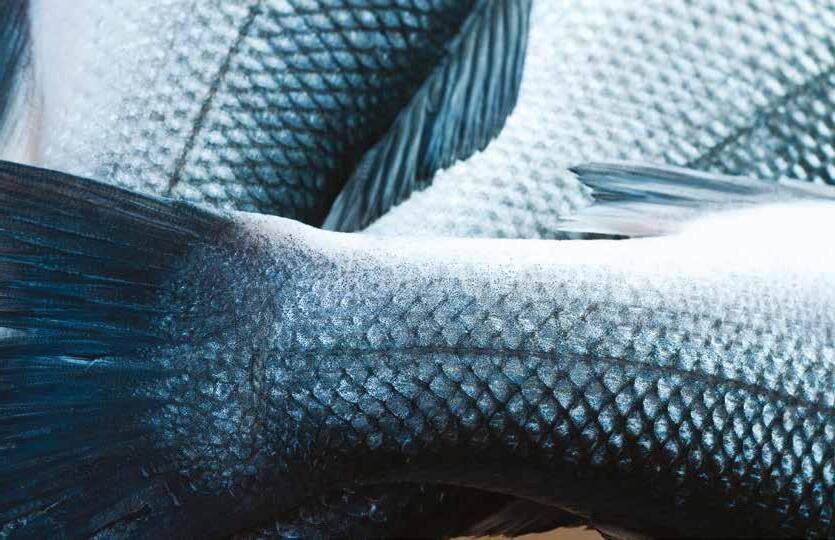







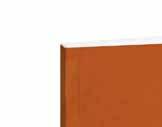



WELCOME
There’s increasing urgency for us in food production industries - and that includes aquaculture and fish farming sectors in particular - to move more quickly towards a sustainable future.
Gilbert Publisher
It’s not that we lack the willpower to embrace a future where energy consumption is continually minimised (especially energy provided by fossil fuels), where equipment recycling is fully implemented in a ‘circular economy’ approach from purchase, through use to disposal and where our raw materials are evaluated not only for their nutritional values and the cost of production, but also for their carbon footprint.
After all, we recognise that at present the cost of feed in our fish farming operations make up on average a staggering 80-plus percent of a farm’s operational costs per rotation.
I draw this to your attention as Dr Brett Glencross's column this month tackles this important subject. He focuses on the responsibility our industry needs to accept when sourcing its protein raw materials and to consider their cost of production in terms of their environmental footprint - and we should not ignore that valuation just because a raw material being sourced is considered a by-product from another industry or industria process.
He points out that we have very little information through certification schemes as to the footprint most raw materials hav e coming forward for aquafeed production. This is an area that needs greater evaluation and documentation so that our entire 53 million tonnes (up 7.25 percent on 2021 according to Alltech's Global Feed Survey published in January 2023) of annual aqua feed production in 2022 can be accurately assessed for its environmental impact.
Without this information it is unlikely we can make meaningful decisions about how to make reductions in our overall carbon foodprint and become one of the most sustainable food producing industries worldwide.
Other sectors, notably the livestock industry, have progressed faster using purpose-built software solutions that pull together information from certified sources to provide farmers with meaningful information to make informed decisions about how to adopt more sustainable practices. This includes the purchase and use of their feedstuffs. I point specifically to the ‘sustainability service’ called Sustell offered by dsm-firmenich as one example from the livestock sector that is currently being modified to meet the needs of fish farmers. We reported on this planned development in June last year. Alltech and ADM are two other companies actively pursuing these goals and there are many other working with their customers in this area of development.
International Aquafeed has a role to play here as well. We want to see the industry’s carbon footprint reduced and we support the drive towards greater sustainability in the way we farm fish.
As I see it, our responsibility is to bring to your attention to the developments that are taking place in a timely manner and to provide
examples of individual and company experiences, encourage the industry to be more proactive and to record the views and suggestions that offer practical and realistic ways forward. It’s a task we all need to engage with in order to meet the expectations of retailers and consumers who are already formulating policies with regard to the environmental costs of their future food supply chains.
So be sure to take time to read Dr Glencross’s column this month. Give it some thought and consider the implications he outlines for your operation. Please let me have your response;what are your experiences, what are the challenges you face in this critical area of sustainability/carbon footprint management and the likely impact on your production systems?

Technology from another industry
With future industry developments in mind, I’m pleased to point out that we have a feature by Aidan Connolly, the president of AgriTech Capital of the USA. While his is an investment company, Aidan brings his insights to the direction of food productionincluding aquaculture - with regard to the Internet of Things (IOT) and the adoption of technologies from other sectors outside the food industry. In this article he looks at advances in health care services that might offer solutions to issues being faced in the aquaculture sector. His feature starts on page 16.
Other features in this issue look at the restoration of the oyster in the UK (page 14) and a new generation of extrusion systems for aquatic feed production by Famsun.
Claudia Figueiredo Silva of Zinpro in the USA and Dr Abdel-Fattah El-Sayed of Egypt have come together to report on benefits from boosting tilapia performance with organic trace minerals (page 26). That is followed by our own managing editor Jyothsna Nelloolichalil reporting on seaweeds and the benefits they provide when used in shrimp feeds (page 30).
Don’t overlook this month’s Fish Farming Technology Section where we report on one Scottish company’s method of controlling its feed distribution via remote controlled digital systems (page 36), nor our Technology Showcase (page 40-41) before our Case Study on Sablefish aquaculture (page 42).
Finally, we move into our Events Section which this month features the VIV Türkiye 2023 and the emphasis placed on aquaculture.
Our team was in attendance to represent for all three of our monthly magazines and to show that aquaculture is part of the wider animal protein production chain.
We report on the Seaagricuture EU23 event with its focus on seaweed and in addition we pre-announce the AquaNor 2023 event being held in Trondheim, Norway in the third week of this month.
This edition will be in the hands of our readers at this important European bi-annual event for the salmon and other industries both in English and in Norwegian! Make sure you ask us for a copy if you are planning to attend this year. Happy reading.
www.aquafeed.co.uk
Roger
– International Aquafeed and Fish Farming Technology
Recently I asked a young student if he knew what the meaning of ‘Emeritus Professor’ was, and he confidently replied, ‘oh it is a professor who had a distinguished record but has now passed away and been honoured’. It was indeed very humorous, and I told him I was very much alive and well, and keen to grade his assignment. I have also been called the Emirates Professor which is lovely and encourages me to fly higher in my career. Far from absolute retirement, I am tasked with many projects and this summer has been quite frantic.

I am presently working very closely with the University of Veterinary and Animal Sciences at Lahore, Pakistan, and the Punjab with respect to several fish nutrition projects on tilapia, snakehead and rohu carp. This is in collaboration with my close friend and colleague Dr Noor Khan and I cosupervise some of his PhD students. As such, I follow Pakistan in the news and observe its current political scene and fiscal status and relationship to the Indian subcontinent. Pakistan has recently reached a preliminary deal with the International Monetary Fund (IMF) worth about US$3 billion that could help stabilise its precarious economy and lift the nation out of a crisis that has pushed millions to the brink. The staff-level agreement is subject to validation by the IMF’s executive council, which is expected to have fully considered the request by mid-July 2023. The agreement, which had been delayed for months, provides the country of about 220 million much needed access to US dollar funding, enabling additional financing from creditors and mitigate the risk of default, after growth stalled and inflation rose sharply over 2022/23. “The new Stand-by Arrangement (SBA) will help to stabilise a policy anchor and a platform for financial support from multilateral and bilateral partners in the period ahead,” the IMF has stated. It comes after Pakistan experienced devasting floods last year, further compounding the economic misery of millions, driving families into poverty, and leaving many unable to afford essentials such as food, fuel, and medicines. The country was also hit by an international commodity price spike in the wake of Russia’s war in Ukraine. Climate change is also making a significant impact and its aquaculture industry was seriously impacted. However, Aquaculture in Pakistan has been growing steadily and has a significant economic value. Pakistan has a long coastline along the Arabian Sea, providing favourable conditions for aquaculture activities. Additionally, the country has numerous rivers and lakes suitable for freshwater aquaculture. In terms of scale, Pakistan has seen a gradual increase in aquaculture production over the years. According to the Food and Agriculture Organization (FAO) of the United Nations, Pakistan's aquaculture production was estimated to be around 404,000 metric tonnes in 2018. However, it's important to note that specific data for subsequent years might not be available and subject to inaccuracy, especially now in the light of the very adverse weather. The economic value of aquaculture in Pakistan has been considerable, both in terms of domestic consumption and export potential. Pakistan is presently exporting fish worth US$ 350 to 400 million per year. Aquaculture contributes to Pakistan's economy by generating income, providing employment opportunities, and contributing to the Gross Domestic Product (GDP). The exact contribution varies annually but has been estimated to be around one percent of the country's GDP.
Fish is an essential source of protein for the population, and the demand for fish and seafood products has been rising due to increasing population and changing dietary patterns. The aquaculture industry will be playing a significant role in meeting this demand. Pakistan has been exporting

fish and seafood products to various international markets, including the Middle East, Europe, and North America. Shrimp, prawns, and various fish species such as tilapia, catfish, and trout are among the key aquaculture products exported. Furthermore, aquaculture provides employment opportunities and income generation for many individuals, particularly in rural areas where fish farming is prevalent. It contributes to poverty reduction and promotes rural development in the country offering stability and less dependency on city employment and crowding issues.
Speaking of a country on the spice trail route from China, I am intrigued by the increasing interest in different spices being added to pet diets, animal feed for production (poultry, swine and ruminants) and of course for fish in aquafeeds. Herbal supplements and spices can be used in fish and shrimp diets for various purposes, including improving feed efficiency, enhancing growth performance, boosting immunity, and reducing the incidence of diseases. While there are many herbs and spices being researched globally. I myself published a comprehensive review of such spices and herbs used in aquaculture with a colleague in Iran led by Seyed Hossein Hoseinifar in the prestigious scientific journal ‘Reviews in Fisheries Science & Aquaculture’ back in 2020. Here I list some examples of commonly studied ones for application in aquafeeds.
Garlic (Allium sativum): Garlic is known for its antimicrobial properties and potential to enhance immune responses in aquatic animals. It has been researched as a feed additive for fish and shrimp to improve growth, feed utilization, and disease resistance. Turmeric (Curcuma longa): Turmeric contains curcumin, a compound with antioxidant, anti-inflammatory, and antimicrobial properties. Studies have shown that including turmeric in fish and shrimp diets can improve growth performance, immune function, and disease resistance. Ginger (Zingiber officinale): Ginger has been investigated for its potential benefits in fish and shrimp nutrition. It possesses antimicrobial and antioxidant properties and may contribute to improved feed utilisation, growth, and immune responses. Oregano (Origanum vulgare); Oregano is rich in essential oils with antimicrobial properties. It has been studied for its potential as a natural growth promoter and immune stimulant in fish and shrimp diets. Cinnamon (Cinnamomum verum); Cinnamon contains several bioactive compounds that exhibit antimicrobial and antioxidant activities. Research has shown that incorporating cinnamon in fish and shrimp feeds can enhance growth performance, disease resistance, and digestive enzyme activities. Neem (Azadirachta indica); Neem has been investigated for its potential use as a natural immunostimulant and growth promoter in aquaculture. It contains various bioactive compounds that possess antimicrobial and antiparasitic properties. Green tea (Camellia sinensis); Green tea and its extracts contain polyphenols and catechins, which have quite strong antioxidant and antimicrobial properties. Studies have indicated that green tea can enhance growth performance, feed utilisation, and disease resistance in fish and shrimp.
It's worth noting that the efficacy and optimal dosage of these herbal supplements and spices can vary depending on the species, life stage, and specific conditions of the fish or shrimp being studied. Therefore, it is important to conduct species-specific research to determine the most effective and safe application of these additives in aquaculture.
So next time you add these spices to our favourite sauces, casseroles, and curries we may consider all their extra benefits to farmed aquatic species to ‘spice up’ their production life. Chinese and Indian herbs and spices are more than just folklore when it comes to health and welfare.
4 | August 2023 - International Aquafeed
Professor Simon Davies Nutrition Editor, International Aquafeed
I was tidying up my bookshelves the other day, and I came across an old book I had not seen for a long time: the proceedings of The First International Conference on Fish Farming Technology, which was held in Trondheim, Norway, 9 – 12 August 1993, just before Aqua Nor 1993 (13 – 17 August 1993). In other words, exactly 30 years ago.
The discovery of the book made me curious. What was the state of fish farming technology 30 years ago? We hear that massive progress has been made over the past decades, and that may be so. But the book contained an impressive collection of papers that showed that even 30 years ago, technology was far advanced.
In the Preface, the editors said: “As fish farming moves into its “industrial phase”, technology will be an important factor in determining its successful development.” And history has shown just how true this statement was.
A total of 81 papers were presented, on some very complex issues of a scientific nature. This is what brought modern fish farming forward.
Aquaculture technology has come a long way, and still has a very long way to go. Scientists from all over the world are turning their attention to ever new issues and approaches. The industry itself is becoming more and more complex and science oriented. Some of the new technologies that are making their way into aquaculture include automation, robotics, cage construction, machine learning and artificial intelligence.
Automation is said to be one of the things that will change our working life the most in the coming years. The industry has major challenges, particularly related to salmon lice and environmentally harmful emissions. New technology will hopefully contribute to reducing these problems in the future. New technology is used in the fight against salmon lice. One example is the “stingray” technology, where a robot quickly registers whether the salmon has lice. If there are lice, the robot fires laser shots that kill them, without harming the fish - and everything therefore happens completely automatically. It both looks and sounds undeniably like science fiction, but the technology is actually already on the market.
Machine learning ensures that the programme used becomes
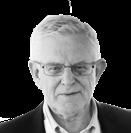

more and more intelligent over time. The area of use can also be extended to lice counting and biomass measurement, where the latter means how many tonnes of farmed fish are in the cage.
The development of cages will continue, and new technologies will be applied. Some cages are being located further out to sea, where the lice problems are smaller and the currents will thin out and transport waste materials further away. There is also a lot of research being done on the development of closed and semi-closed facilities at the moment, which could have a major impact on problems with salmon lice, escapes and emissions from production. However, much remains to be done before these concepts become so profitable that they can seriously replace today's open cages. While progress was fast, - sometimes explosive -, in the early days, it is now much slower. Much more incremental. Tiny steps are made towards an ever more sophisticated technology that produces tiny improvements in performance. But these tiny steps are necessary. In spite of the enormous efforts that go into making such tiny steps, it is all necessary. So much is known about aquaculture technology today, that every step forward requires more research, more inventiveness on the part of the scientists. The search for improvements will never stop, and we should be thankful that it will not, for the world needs these improvements. They contribute to solving the problem of how to feed a growing population. It is commonly agreed that the ocean and aquaculture is a large part of the solution. So the scientists who study these tiny problems to make tiny advances deserve our support and accolade.
It is not always easy to say which solutions will be winners in the future, but with a wealth of new technological developments, we can at least be quite confident that fish farming is facing an exciting and high-tech future. Tomorrow's fish farming will probably look significantly different from today’s.
With these words, I wish you all welcome to Aqua Nor 2023, where some of the new technology will be on display! Even if you are not going to Trondheim for the physical event, you can be present through the net. Just check www.aqua-nor.no. And the good thing about the online version of the conference is that it will remain accessible online until the end of April 2024.

aquafeed.co.uk
FISH FARMING TECHNOLOGY
Erik Hempel
The Nor-Fishing Foundation
Perendale Publishers Ltd
7 St George’s Terrace
St James’ Square, Cheltenham, Glos, GL50 3PT, United Kingdom Tel: +44 1242 267700
Publisher Roger Gilbert rogerg@perendale.co.uk
Managing Editor
Joy (Jyothsna) Nelloolichalil joyn@perendale.co.uk
International Editors
Dr Kangsen Mai (Chinese edition) mai@perendale.com
Prof Antonio Garza (Spanish edition) antoniog@perendale.com
Erik Hempel (Norwegian edition) erikh@perendale.com
Editorial Advisory Panel
- Dr Abdel- Fattah M. El- Sayed - Dr Alessio Bonaldo
- Dr Allen Wu
- Prof Charles Bai
- Dr Daniel Merrifield
- Dr Domique Bureau
- Dr Elisabete Matos - Dr Eric De-Muylder
- Dr Noor Khan
- Dr Pedro Encarnacao
Editorial team
Prof Simon Davies sjdaquafeed@gmail.com
Shannon Parsons shannonp@perendale.co.uk
Niamh Cassidy niamhc@perendale.co.uk
International Marketing Team
Darren Parris Tel: +44 7854 436407 darrenp@perendale.co.uk
Latin America Marketing Team
Clarissa Garza de Yta Tel: +52 669 120 0140 clarissag@perendale.com
Cristina María Roldán Otero Tel: +44 1242 267700 cristinaperendale@gmail.com
Egyptian Marketing Team
Mohamed Baromh
Tel: +20 100 358 3839 mohamedb@perendale.com
India Marketing Team
Dr T.D. Babu +91 9884114721 tdbabu@aquafeed.org
Asia Marketing Team
Dante Feng Tel: +886 0227930286 dantef@perendale.com
Nigeria Marketing Team
Nathan Nwosu Tel: +234 8132 478092 nathann@perendale.com
Digital community manager
David Harvey davidh@perendale.co.uk
Design Manager

James Taylor jamest@perendale.co.uk
Circulation & Events Manager


Tuti Tan
Tel: +44 1242 267706
tutit@perendale.co.uk
Development Manager
Antoine Tanguy antoinet@perendale.co.uk
Aquafeed Journal journal@perendale.co.uk

FISH FARMING TECHNOLOGY
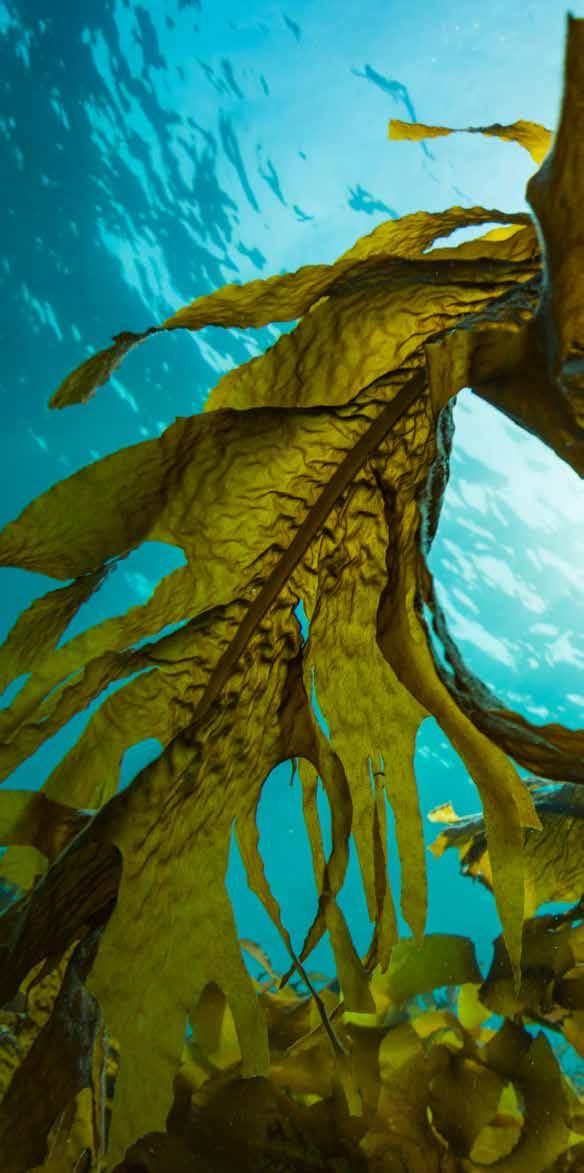
IN THIS ISSUE
COLUMNS ©Copyright 2020 Perendale Publishers Ltd. All rights reserved. No part of this publication may be reproduced in any form or by any means without prior permission of the copyright owner. More information can be found at www.perendale.com ISSN 1464-0058 REGULAR ITEMS 8 Industry News The Aquaculture case study
4
5
Hempel 66 Industry Faces 64 The Aquafeed Interview 60 The Market Place 11 Dominique P Bureau 12 Brett Glencross August 2023 Volume 26 Issue 8 44 Industry Events 40 Technology showcase 42 Sablefish Aquaculture: Aquaculture projects in the Pacific Northwest
3 Roger Gilbert
Professor Simon Davies
Erik
THE BIG PICTURE
Seaweed and its benefits in shrimp feed
See more on page 30
FEATURES
14 Native oysters - Selective breeding and their benefits
16 Digital lessons – what our hospitals could teach fish farms
20 New generation extrusion system promotes an upgradation in aquatic feed production
26 Small adjustments for great benefitsBoosting tilapia potential with organic trace mineral nutrition
30 Seaweed and its benefits in shrimp feed

FISH FARMING TECHNOLOGY
36 Remote control: Feed remotely from anywhere on earth
Gael Force Group moves ahead with SeaQureFarm™
Gael Force Group has taken a substantial step forward in its plans to deliver its integrated SeaQureFarm™ by announcing an exclusive partnership for the prototyping and production of their ground-breaking semi-closed containment solution for the aquaculture sector, SeaQureWell™, in 2024.
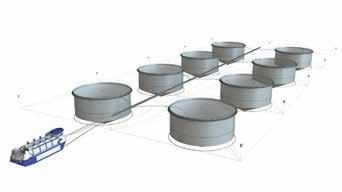
SeaQureFarm™ has the potential to unlock global ambition for a greener, carbon-friendly, and more efficient way of producing healthy nutritious food protein through improving the sustainability of farming of the seas. It is designed to deliver improved fish health, reduced predation, prevent seabed depositions and reduce egg-to-plate emissions while enabling on-farm circular economies and turning a waste problem into an energy solution.
As an integral part of SeaQureFarm™, the SeaQureWell™ is an arrangement where seawater is pumped and pushed into a floating enclosed “well” with its floating collar at the sea surface. The collar supports the Well and its pumping arrangements which lifts deeper coastal water into the well creating an in-well temperature profile that is warmer in the winter and cooler in the summer.
The SeaQureWell™ will be constructed of engineered high-quality composite membrane material, cut, and welded to form the ‘Well, with structural floatation at the surface and a rigid sub-surface service and support structure. It aims to provide and maintain a secure controlled environment to safeguard healthy growing fish against external environmental threats to the fish from sea lice, gill amoeba, jellyfish and algae bloom as well as protect against sea mammal predation. Additionally, faecal depositions along with any uneaten food will also be captured in the ‘Well’ for on-site recovery and reduction for reuse.
The Scottish technology and equipment manufacturer
has been researching and developing its unique integrated SeaQureFarm™ concept for several years. Last year it commissioned aquaculture expert, Knut Senstad, to deliver a highly detailed business case for the concept, revealing key economic, health, and environmental savings in a range of farming scenarios.

Partnering with Gael Force on the production of the prototype is Northern Ireland based Cunningham Covers, known for their expertise and large factory capacity in the manufacturing of clever protective covers and containment products from high-tech, high-strength flexible materials. Their experience in creating durable and customised solutions spans more than 50 years, and today they produce and supply a range of specialised cover products for aerospace, offshore, and aquaculture applications, including fresh-water treatment bags, fresh-water storage bags, lice skirts, and other custom tarpaulin textile products.
For this partnership, Gael Force and Cunningham Covers have also entered a supply partner agreement with Serge Ferrari, a global leader in flexible composite materials. They will provide cutting-edge fabric technology to enhance the performance and durability of the SeaQureWell™ system. The use of innovative materials will contribute to the system’s robustness, flexibility, and resistance to environmental factors.
Gael Force Group Managing Director, Stewart Graham, comments, “By announcing this next major step forward in the development of SeaQureFarm™ we continue to demonstrate our commitment to the continual improvement of a greener, carbon-friendly way to sustainably produce a healthy, nutritious food protein. We share the sector’s ambition of minimising environmental footprint and moving closer to a goal of achieving net zero. In partnership with Cunningham Covers, supported by Serge Ferrari as our specialised material supply partner, I am extremely confident that our collective experience and expertise will enable us to move the dial considerably towards that target.”
Cunningham Covers Managing Director, David Cunningham, comments, “We are delighted to be a long-term partner with Gael Force in this project. Our two companies share core values and ethos, as well as a long-term ambition to grow our presence together in the semi-closed containment fish farming sector, combining the considerable and complementary strengths of both companies.”
Gael Force is aiming to produce a working prototype of SeaQureWell™ in 2024. They have stated that it is immediately open to partnering with finfish producers in Scotland to trial a project next year and is welcoming approaches from customers.
Going mobile
8 | August 2023 - International Aquafeed News
ADB invests in ocean-based aquaculture in Vietnam
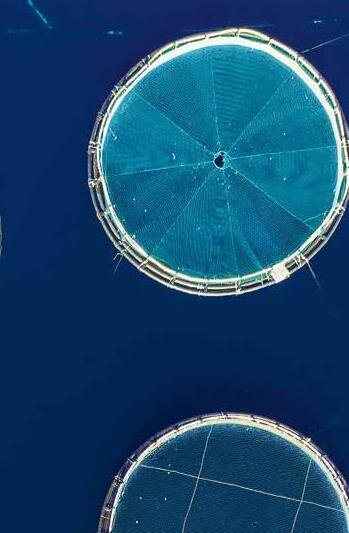
ADB’s investment will fund the working capital to expand Austalis’ operations at Van Phong Bay in central Vietnam and support the development of a second regional production hub in southern Vietnam.
The Asian Development Bank (ADB) and Australis Holdings, Inc. (Australis) signed a US$15 million convertible note to promote climate-resilient, ocean-based barramundi and seaweed aquaculture in Vietnam. The investment will fund working capital to expand Australis’ operations at Van Phong Bay in central Vietnam and support the development of a second regional production hub in southern Vietnam. An additional US$3 million grant will be provided by the Climate Innovation and Development Fund (CIDF), administered by ADB.
“Three billion people across the world depend on seafood for protein, even as global fish stocks fall due to overfishing and temperature rise,” said ADB Director General for Private Sector Operations Suzanne Gaboury. “ADB’s assistance will support the government’s efforts to develop sustainable aquaculture, particularly large-scale farming of high value species for export. Aquaculture can support low-carbon protein production, while tropical ocean farming is more resilient to climate risks. This is our first aquaculture equity investment in Vietnam, and we are proud to partner with Australis.”
Australis is the world’s largest barramundi producer. Also known as Asian sea bass, the species is adaptable and resilient, well suited to aquaculture, with high export value. Australis pioneered the development of modern, large-scale marine aquaculture in Vietnam.
“ADB’s financing will support the continued growth of our operations in central Vietnam as well as the development of a large new regional production hub where we’ve established a group of leases that will allow us to achieve 50,000 tonnes of annual barramundi production,” says Australis Chief Executive Officer Josh Goldman.
The CIDF grant to Australis’ subsidiary Greener Grazing LLC, will support research and development into the cultivation of asparagopsis taxiformis seaweed for commercial ocean farming. This species of seaweed has been demonstrated to significantly reduce enteric methane emissions when included in cattle feed. Seaweed farms can mitigate ocean acidification and enhance climate resilience of marine ecosystems and have carbon sequestration potential.
Launched in September 2021, CIDF is a blended finance facility managed by ADB, established with an initial US$25 million philanthropic commitment from Bloomberg Philanthropies and Goldman Sachs. The fund has the potential to unlock up to $500 million in private sector and governmental investments in support of sustainable lowcarbon economic development.
Established in 2006, Australis is vertically integrated with operations encompassing breeding, hatcheries, ocean farms, processing, packaging, and export. Australis’ consumer-facing brand The Better Fish® focuses on quality, sustainability, and ease of use.
ADB is committed to achieving a prosperous, inclusive, resilient, and sustainable Asia and the pacific, while sustaining its efforts to eradicate extreme poverty. Established in 1966, it is owned by 68 members – 49 from the region.
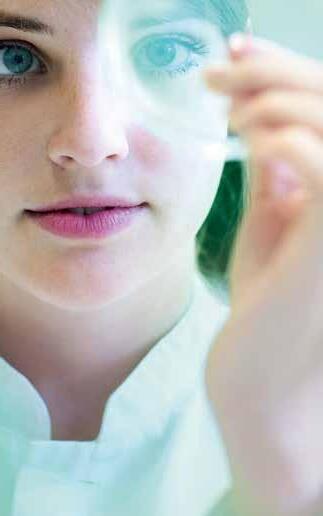
Phileo’s probiotics and active yeast fractions are designed for hatcheries and growing farms to support health, feed efficiency and growth performance . Our sustainable solutions bring innovative responses to fishmeal reduction stakes and environmental challenges. Act with nature for animal care. Join the fish revolution Visit our new website www.phileo-lesaffre.com International Aquafeed - August 2023 | 9 News
New bipartisan bill to support aquaculture farmers and harvesters
US Senator Roger Wicker, R-Miss., joined Senator Whitehouse, D-R.I., and Senator Angus King, I-Maine, in introducing bipartisan, bicameral legislation to uplift and support aquaculture and aquaculture farmers and harvesters. The Sustaining Healthy Ecosystems, Livelihoods, and Local Seafood (SHELLS) Act will create a program office for aquaculture within the US Department of Agriculture (USDA) to bolster shellfish harvesters and seaweed farmers, protect food security, and promote blue carbon ecosystems.
“Seafood is an important component of America’s food supply chain and a major economic driver in communities like Mississippi’s Gulf Coast,” Wicker said. “This legislation would give aquaculture farmers a more direct line to access USDA resources and programs so that they can better meet demand in this growing industry.”
“Shellfish farming is a pillar of the Ocean State’s economy and culture,” said Whitehouse, co-founder of the Senate Oceans Caucus. “Our SHELLS Act will expand federal programs that provide Rhode Island aquaculture farmers the tools and resources to sustainably grow the industry, create new jobs, and continue farming the best oysters in America.”
“For generations, Maine’s ocean economy has supported communities along our coast – aquaculture presents an exciting new opportunity to expand on this long tradition and create more good-paying jobs in the 21st century,” King said. “From shellfish to seaweed, the bipartisan SHELLS Act would give aquaculture entrepreneurs and professionals a designated point person in the federal government who understands their needs and can best respond to them. This is a common sense way to invest in Maine’s aquaculture farmers and harvesters, produce more world-class seafood products, and build on our state’s legacy of sustainable maritime innovation. I am grateful for my colleagues’ bipartisan support on this important effort to grow Mine’s invaluable ocean economy.”
The SHELLS Act also establishes an aquaculture Advisory Committee to oversee program activities, support the development of best practices, provide technical assistance, and acknowledge the history, use, and preservation of indigenous and traditional aquaculture practices and ecological knowledge.

Companion legislation was introduced in the House of Representatives by US Representatives Suzanne Bonamici, D-Ore., Ed Case, D-Hawaii, Rob Wittman, R-Va., Frank Pallone, D-N.J., and Chellie Pingree, D-Maine.
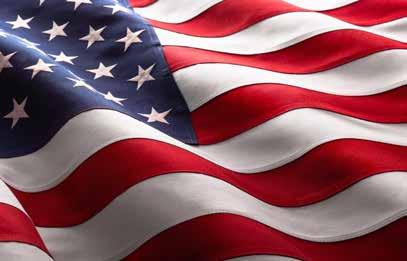
ai1659709269130_IRIDA_PRINT_AD_05-08-22_OUT_102.5x280_ENG.pdf 1 05/08/2022 5:21 pm
News 10 | August 2023 - International Aquafeed
IFFO releases Marine ingredients market trends report

Ataste of the many statistics and analyses that can be found in the Market of intelligence reports that IFFO dedicates to its members is reported below, covering IFFO’s analysis on marine ingredient market trends until May 2023.
Peru’s reduced FMFO production drives global output down
For the regions for which IFFO regularly tracks production of marine ingredients, roughly worth 50 percent of the global output, IFFO reports cumulative total fishmeal production during the first five months of 2023 down by more than 10 percent compared to the cumulative production reported through May 2022. The primary factor driving such decline is the production drop of approximately 50 percent reported in Peru, where the first fishing season has not been authorised yet. At the time of issuing this report there is still no clarity on whether the first fishing season in the North-Centre might be authorised.
As for fish oil, total cumulative output in the first 5 months of 2023 was 22 down YoY. The only countries that registered a positive change YoY were Chile and the USA.
Domestic FMFO production remains poor in China
This year farmers are facing additional risks of economic losses due to escalating costs of aqua feed and stagnating farm-gate prices. Should this trend continue, farmers could be soon exposed to even greater financial risks, similarly, the pig sector continues to face challenges due to weak demand during hot summertime. Pig prices have been on a decline since last October, which has resulted in a continuous although insufficient reduction of the sow stock. The pig sector remains in fact affected by overcapacity and unprofitable farm-gate prices.
Following the implementation of the fishing ban on May 1st on all fishing grounds, to allow the biomass to reproduce, domestic fishmeal and fish oil production remains poor and dependent on little frozen fish caught in the last season and by-products from fish and shrimp processing plants. This situation is expected to persist until the fishing ban is lifted in September. Considering the lower-than-average domestic production both in the second part of the year 2022 and in the first half of 2023, China has continued to increase its fishmeal imports.
Smart Feed Management for Sustainable Shrimp Aquaculture
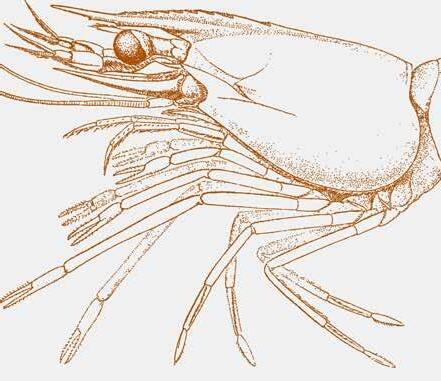
Dominique P Bureau
High priced inputs (i.e., feeds) and decreasing final product prices are creating a perfect storm situation for many shrimp culture operations. These enterprises need to focus on reducing production costs and improving their profitability yet, while there has been considerable focus in terms of research and development on improving the cost-effectiveness of feeds, how efficiently these high value inputs are used at the farm level has been the subject of relatively few efforts.
Rearing animals in an aquatic environment greatly complicates monitoring of growth, standing biomass and feed consumption. A great deal of attention must be paid to the feeding since feed delivered, but not consumed, cannot be recovered or even appropriately quantified. The feeding of crustaceans is even more complicated due to their mode of feeding and feeding behaviour.
Analysis of data from commercial production lots in different regions indicates feeding management is seriously deficient on many shrimp culture operations. Farm employees appear to rely on poor (biased) and relatively archaic approaches to estimate inventory, standing biomass, and appetite of the animals and determine daily feed allocation. The amount of feed distributed appears to frequently be in excess of what the animals truly require. Overfeeding leads to feed wastage, a pure economic loss, and greater waste outputs, which can have dire consequence on water quality and the development of water-borne pathogens and survival of the animals. Conversely, delivering less feed than what is required by the animals to express their growth potential can also be considered an economic loss (opportunity cost) and may greatly affect profitability of the enterprise.
Technological solutions, from smart feeding systems to biomass estimators to production and feeding management software, have been developed and are being implemented on shrimp culture operations. These technological solutions may usher a new era of smart feeding management for shrimp culture operations. Examples of effective use of technology to improve feeding management will be presented.
Dominique P Bureau, Professor, Dept. of Animal Biosciences, University of Guelph & Chief Scientific Officer, Wittaya Aqua International
News International Aquafeed - August 2023 | 11
Brett Glencross
Responsible ingredients depend on sourcing of responsible primary raw materials

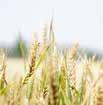
While everyone is touting the importance of responsible feeds, it needs to be noted that this depends for the most part on the capacity for the sourcing of responsible ingredients. This of course depends on the sourcing of responsible primary raw materials. But like many of these quasi environmental and social issues, the devilis-in-the-detail. Afterall, what do we actually mean by “responsible sourcing”? There are various definitions, but responsible sourcing is also referred to as supply chain responsibility and is generally considered a commitment by companies within a defined supplychain to consider social and environmental considerations in addition to economic ones when managing their relationships with suppliers.
In terms of the environmental side of things, issues around land conversion in crop production supply chains, have been one issue at point due to their effects on threatening biodiversity and valuable carbon stores in critical ecosystems (e.g., rainforests in Brazil). Similarly, the sourcing of fish from illegal, unreported, and unregulated (IUU) fishing is another. To address such environmental threats, and in the process reward those who are trying to do the right thing, many such commodity markets have resorted to the development of certification systems, usually initiated by the industries themselves, but often involving broad range of stakeholders to ensure that not only the industry’s agenda is addressed (e.g., MarinTrust and RTRS Certified Soybean). Such systems have been instrumental in driving the progression of improved practices across different industries in addressing their environmental responsibilities.

But what of the social equity? Much has been made of issues around modern slavery, and various freedoms we often take for granted in developed nations but are often lacking in other parts of
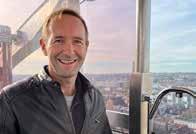

the world. While we hear of slavery associated with some of the high seas fishing fleets, we hear less about forced labour, bonded servitude, and loss of human rights in other sectors, although we know that these issues exist (amnesty.org). Irrespective, by applying a greater degree of scrutiny on the providence of ingredients, their origins and obtaining independent validation of claims of social as well as environmental standards, seems to be the best way forward here too.
So, based on these examples of setting both environmental and social standards, where do various feed commodities sit in terms of independent certification standards being applied? Presently just under 50 percent of all global fishmeal production (~3 million tonnes) is certified with MarinTrust certification and in many cases also holds Marine Stewardship Council (MSC) certification. About 6 million tonnes soybean production is certified by the Roundtable on Responsible Soybean (RTRS), which although constitutes a huge volume, is only about 1.5 percent of production (391 million tonnes in 2022/23), and despite that low percentage, it is still one of the better certified of all agricultural commodities. However, beyond these two ingredients, there are few other protein sources that have any similar such certification applied to their sourcing. While arguments have been made for the lack of need for such responsible sourcing criteria for many other ingredients, especially those that are by-products of other sectors, the reality is that all ingredients have an environmental footprint, either directly or indirectly as part of their sourcing. Responsibility also implies traceability, which is a cornerstone of food safety policies. The Global Dialogue on Seafood Traceability (GDST) is working to create the first-ever global industry standards for seafood traceability and standards such as MarinTrust will align with GDST’s data requirements. A lack of responsibility in production of one resource, does not necessarily mean that a by-product is free from such responsibility. As we can clearly see, sourcing responsible ingredients depends on sourcing of responsible primary raw materials.
BOURNE AES R C H & RECRUITMENT SELE C T I NO � CHIEF COMMERCIAL OFFICER � GENERAL MANAGERS � MANAGING DIRECTORS � CHIEF MILLERS � FEED & POULTRY MANAGERS � MAINTENANCE MANAGERS � R&D NEWPRODUCT DEVELOPMENT � SALES & MARKETING � PLANT MANAGERS � CFO’S ���� bournerecruitment.co.uk ���� +44 7764 465 897 THE EXPERT IN FEED, FLOUR MILLING AND FOOD PRODUCTION RECRUITMENT POSITIONS RECRUITED: RECRUITING GLOBALLY 12 | August 2023 - International Aquafeed News
OSF Ballan Wrasse trial proves success
An independent trial conducted at Otter Ferry Selfish in Scotland, showed the inclusion of Oregon-Stim Forte, a natural and sustainable feed addictive, to the commercial diets of juvenile ballan wrasse resulted in improved growth performance, survivability, lower feed conversion and higher specific growth rates.

Oregon-Stim Forte is a high-quality functional feed ingredient, manufactured by Anpario and specifically developed for aquaculture, containing 100 percent natural oregano essential oils and quillaja saponins.
Lawrence Brown, Senior Technical & Account Manager
Morrisons to transfer over UK£100,000 Apprenticeship Levy fund to the fishing sector
Morrisons is transferring an Apprenticeship Levy fund of over £100,000 to Supplytrain to help train ten new sea fishers for the South Western Fish Producer Organisation (SWFPO).
The money will support the first fisher apprenticeship programme in England. The 18 month apprenticeship allows students to get a hands-on experience and learn about the whole fishing operation from sea to sale.
As an apprentice, students will be employed by Supplytrain, but get to work across different boats within the SWFPO membership, catching different fish and learning from experienced crew while also studying seamanship, gear construction and how to care for the catch at South Devon College.
The life of a commercial fisher is physically demanding but immensely rewarding providing the skills and opportunities to become an experienced deckhand, a skipper, a marine engineer or even a future vessel owner.
at Anpario commented, “Ballan wrasse are increasingly utilised in salmon farming for sustainable sea lice management. By improving the performance and survivability of ballan wrasse using Orego-Stim Forte we’re able to drive productivity, fish welfare and ultimately reduce the overall environmental footprint. We’re excited to be working with cleaner fish producers and Aquafeed manufacturers to harness the benefits of our functional feed ingredients.”
This research was part-funded by UK Agritech Centre CIEL as a successful recipient of aquaculture project seed funding.
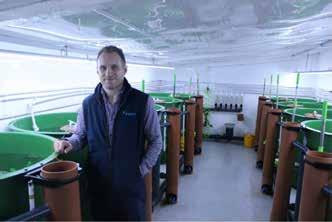
The Government Apprenticeship Levy is paid by employers to help fund apprenticeship programmes and Morrisons has agreed to transfer £100,000 of its funds to pay for the SWFPO’s first cohort of ten apprentices. The deadline for applications is the 31st July and the first cohort will start their programme this September.
Morrisons has supported craft apprenticeships in its stores including Fishmongers, Butchers and Bakery roles. Over 2,500 colleagues in-store have completed the programme to date with a further 200 apprentices planned to enrol in September.
Morrisons Sustainable Sourcing and Fisheries Manager, Sophie Jenkinson said:
“The fishing industry is an important and integral part of Morrisons and that is why we’re pleased to be supporting Supplytrain and SWFPO by transferring some of our Apprenticeship Levy to help recruit and train the sector.”
“Recruitment is a real issue across the entire fishing industry right now, with an ageing demographic and shortage of skilled crew.” Said Juliette Hatchman, CEO at SWFPO, “A lack of skilled crew has a significant impact on the entire seafood supply chain. The
catching sector is the start of the supply chain, so without boats going to sea, there is no supply chain. SWFPO members are not alone in facing challenges with attracting the right personnel. This apprenticeship is a great way to grow new talent within our industry by developing a motivated, skilled and qualified resource that the whole industry will ultimately benefit from. Not only does it improve the attractiveness of the sector as a professional and valuable career pathway, but improves safety within the sector –all of which make it a much needed and worthwhile investment.”
Phil Golding, Managing Director at Supplytrain said: “It’s fantastic to have Morrisons as a partner supporting the first ever Fisher Apprenticeship in the country. As a flexi-job apprenticeship agency, we’re excited to be able to employ and support fresh talent to start a career in this rewarding industry, and hope this is the first of many cohorts in the years ahead.”
In 2021 Morrisons acquired Falfish, a sustainably sourced seafood wholesaler based in Cornwall. To date, Falfish supply the majority of Morrisons fish and shellfish that is then freshly prepared by Morrisons fishmongers based in-store.
International Aquafeed - August 2023 | 13 News
Native oysters
Selective breeding and their benefits
by Matthew Johnston, Managing Director, The Oyster Restoration Company, UK
Selective breeding programs are a standard part of animal production. They are an important contributor to improving growth rates and product quality while decreasing the cost of production. Oysters are no different.
Selective breeding programs have transformed terrestrial animal production, and now they’re starting to transform the Pacific oyster industry. At The Oyster Restoration Company, our aim is to provide a similar transformation for the native flat oyster for farming, but also to preserve the diversity of its genetics for restorative aquaculture.
Native flat oyster (Ostrea edulis) populations in Europe have been decimated by overfishing and habitat removal and disease. Only 5 percent of natural flat oyster beds remain today.
Selective breeding as a solution
To combat this decline, we can employ selective breeding. Selective breeding for natural disease resistance is an effective and sustainable method to increase survival of a species in all regions, including where a known disease agent is present.
The Oyster Restoration Company has now established a large breeding program consisting of multiple family groups. We select fast-growing lines and other favourable traits for the aquaculture market. We select disease-resistant lines with varied genetics that closely resemble existing populations in the release area for the restoration and environment markets.
“The genetic health of our oyster populations within our hatchery is as important as the physiological health of the oyster themselves” said Dr Matthew Johnston (Managing Director of The Oyster Restoration Company).
Typically, selective breeding programs of oysters are used to improve aquaculture production. However, at The Oyster Restoration Company, we are also utilising this approach to benefit the ecological restoration of native flat oysters.
The Oyster Restoration Company has a vast library of broodstock native flat oysters, comprising over 6,000 pieces from five different populations from Europe and the United Kingdom. This vast broodstock library allows The Oyster Restoration Company and its customers great flexibility in ensuring that the genetics of the stock being restored or farmed in a particular area closely resemble the existing natural or native populations.
Our vast broodstock library is particularly important, as previous research on the east coast of The United States of America showed that selectively bred oysters don’t perform equally well across growing environments; they grow best in their naturalised sites. This finding is influencing how we approach our breeding and restocking programs at The Oyster Restoration Company.
Increasing necessity
Restoring native oyster populations is more important now than ever. The native flat oyster has been one of the most sought seafood products since the Roman times and represented an important ecological and aquaculture species in the European areas throughout the last century.
Oyster reefs play an important role in ecosystem services, providing many benefits such as shoreline stabilisation, water filtration, and food and habitat provision for larval marine species, carbon burial, and nutrient regeneration. The habitats for native flat oyster are, however, endangered in Europe and are now identified as a priority for protection and restoration in European marine protected areas.
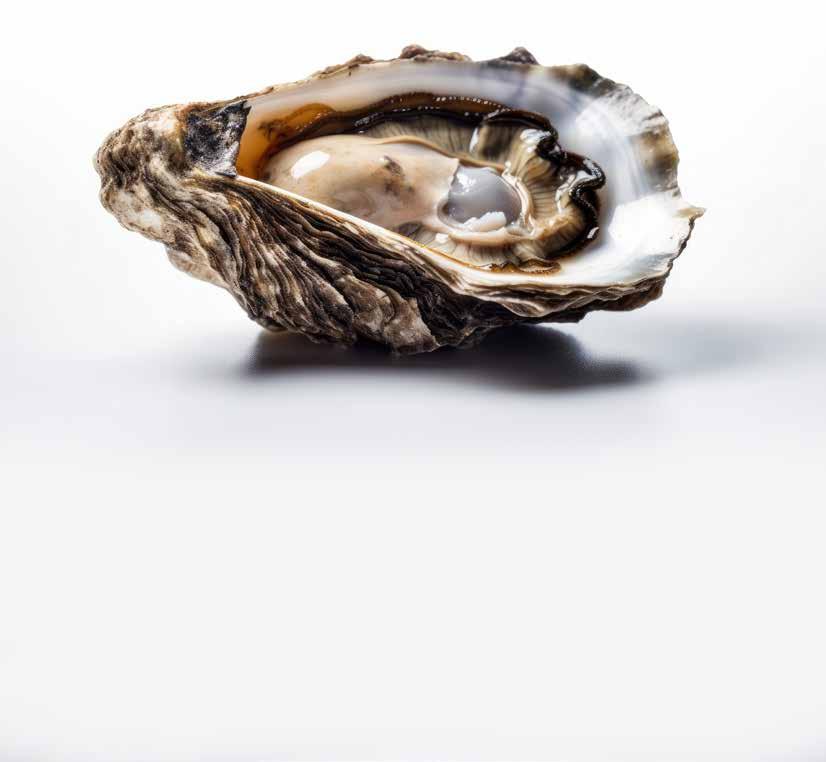
14 | August 2023 - International Aquafeed
There are many essential considerations when establishing a breeding program. Perhaps the most important is trait selection. Although farmers require fast growth, other traits are likely to influence profitability, and these need to be balanced in selection decisions. Within selective breeding programs for Pacific oysters, growth time, shell shape, survival, time required to reach market condition, and uniformity are the main traits that drive lower costs of production. This is likely to be similar for the farming market of the native flat oyster.
To reduce unintended artificial selection known as domestication selection, the breeding program is carefully managed by a leading genetics company, Xelect Ltd, based in St Andrew’s, Scotland. By working closely with Xelect, The Oyster Restoration Company can assist conservation efforts by ensuring a range of phenotypic selections are occurring. With the various populations of native flat oysters from the United Kingdom and Europe, we can tailor the genetic lines so they closely resemble the local population where the conservation effort is taking place.
“It is important to note that we are not artificially changing the oyster’s DNA, nor are we manipulating the number of its chromosomes or introducing foreign DNA.” said Dr. Nikolas Sachlikidis (Managing Director of Aquaculture, Cadman Capital Group). The goal is to provide a product that is matched to it surrounding environment and has traits that allow it to survive and thrive in the wild or under farming conditions, Sachlikidis said.
An economic and sustainable option
Through working with Xelect Ltd, we’ve estimated that the breeding program will reduce the cost of production of native flat oysters over the next decade and assist the regeneration of a threatened species in the wild. It will also give existing Pacific
oyster farmers in Europe a native, natural alternative to farming an exotic oyster species.
The Oyster Restoration Company, with the assistance of its commercial genetics company, Xelect Ltd, recently developed a custom panel of 439 single nucleotide polymorphism (SNP) markers for native flat oysters as a tool for the genetic analyses of the future breeding program. This is important because to make the links between phenotype (the oyster’s physical appearance) and genotype (the genetic composition of the oyster), the breeding managers need to understand the oyster’s genetic sequence and to locate the genetic variations, single nucleotide polymorphisms (SNPs), that control the traits of interest.
After optimisation of the 439 working SNP’s, 37 were identified as functional candidates. 36 of these were associated with Bonamia disease resistance and one was for growth. This new tool will be used to assess the genetic health of the population and to build an accurate pedigree, which is required for genetic broodstock management and trait improvement.
Now, we must look to the future of the selective-breeding program. We will investigate new traits that can help native flat oysters survive and thrive in various ecological niches through the coastlines and offshore habitats of Europe and the United Kingdom.
Native flat oysters are essential for the ecological health of our oceans. As filter feeders, they help improve water quality because they filter their food from the water. The continued improvement of native flat oyster stocks with advanced breeding technologies will be necessary for the sustainable development of oyster farming and the re-establishment of a keystone species to allow marine biodiversity to thrive.
www.oysterrestorationcompany.co.uk
Optimal nutrition for exceptional RAS shrimp farming
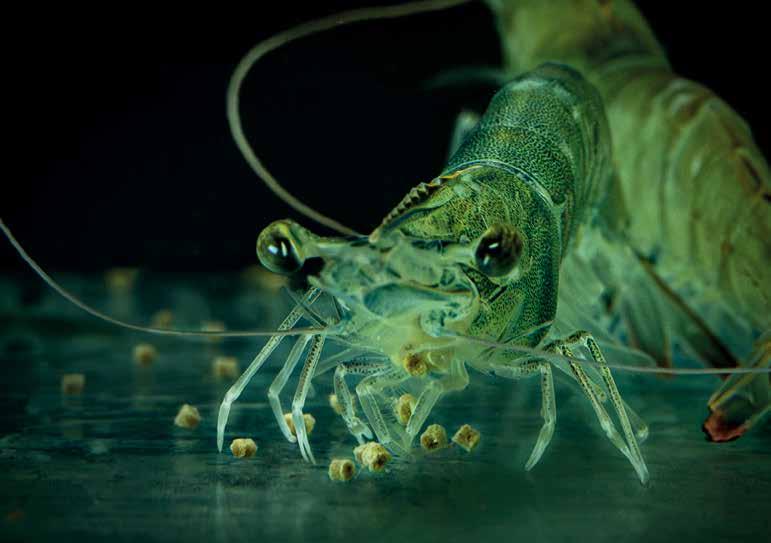
Aller Aqua RAS Shrimp feeds are a carefully selected range of documented solutions:
High palatability and feed uptake
Fast and uniform growth
Low water pollution
LET’S GROW TOGETHER
WWW.ALLER-AQUA.COM
International Aquafeed - August 2023 | 15
Digital lessons
– what our hospitals could teach fish farms
by Aidan Connolly, President, AgriTech Capital, USA
The healthcare industry has undergone a profound transformation thanks to technology, and now these same cutting-edge developments are making their way to aquaculture. Robots, the Internet of Things (IoT), and artificial intelligence (AI) have become commonplace in hospitals, care facilities, and even private residences. As the aquaculture sector prepares for a similar technological shift, the healthcare industry can serve as a potential blueprint for the future.
The tech-induced evolution in the healthcare industry suggests two trends for aquaculture: the adoption of technology will alter work and leadership but will not decrease the number of individuals employed on aquafarms. The healthcare industry has embraced digital products that use a test-and-adapt approach to ensure client satisfaction, and aquaculture would be well-served to do the same for fish farmers.
Knowing these trends, how can aquaculture industry professionals navigate this future to positively transform the food chain?
Robots
Up to 3,000 blood samples are transported by robots at Aalborg University Hospital from bedside to lab, every day. Without deviating from their path or task, these robots maintain stable temperatures during transport which allows for consistent, accurate sample analysis and improved patient care.
Aquatic robots are being embraced in a similar manner on the farm. Companies like Aquabyte and Deep Trekker are using robots to monitor, feed, and maintain optimal water quality. Robots are offering efficient, precise, and economical solutions to many challenges regarding fishery management and labour shortages. Their uses are expected to expand.
Internet of things (IOT)
IoT technology, smart devices and wearables, like Fitbits and Apple watches, are changing work for hospital bedside staff. Because wearable health devices can provide real-time, relevant data for healthcare providers, it eliminates the need for constant monitoring and frees the bedside staff to attend to other tasks. Likewise, aquaculture is embracing IoT sensors to monitor water conditions for temperature, oxygen levels, pH balance and other factors. Companies like AquaByte use sensors and data platforms to track water quality and fish feeding, all in real-time. E-Fishery, the creator of the eFishery Feeder which revolutionises fish and shrimp farming by automating feeding, is ambitiously marching towards a milestone goal: establishing a digital cooperative with one million fish farmers by 2025. Monitoring and feeding used to be time-consuming tasks with frequent observational errors. Now, IoT sensors can accurately analyse aquafarming outputs in real-time.
Artificial intelligence (AI)
Medical errors cost the healthcare industry $1.9 billion annually and the lives of over 200,000 people. Errors caused by fatigue, memory, lack of experience or training and misapprehensions could be reduced when AI supports decision-making. AI in healthcare, used in diagnostic tools like Nanox AI and Aidoc, has led to better disease detection and patient outcome predictions. AI can likewise reduce human errors within the aquaculture industry through predictive analytics. Startups like Manolin have developed AI platforms to help aquafarmers get real-time insights and data-driven recommendations. In fact, AI computations
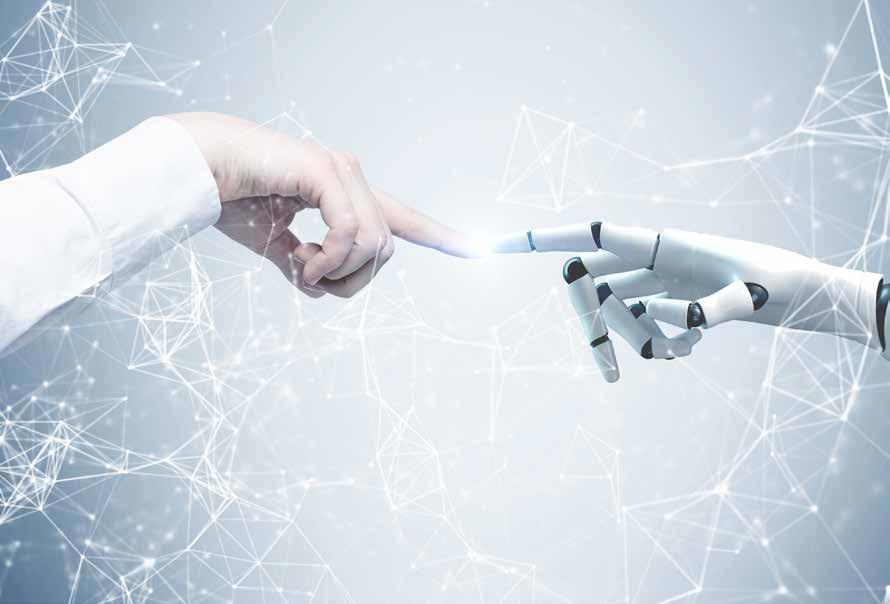
Robots are offering efficient, precise, and economical solutions to many challenges regarding fishery management and labour shortages. Their uses are expected to expand.
DRAFT 16 | August 2023 - International Aquafeed

Life, made easier. jefo.com Jefo PEAK Program Production & Performance Improves Feed Conversion Increases Digestibility
Environmental Sustainability Increase you profit in aquaculture with our Jefo Protease. DRAFT
Improves
Hatcheries

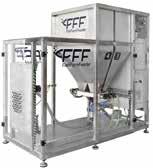


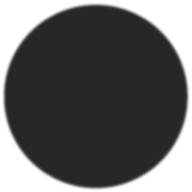








Pellet 50-800 µ
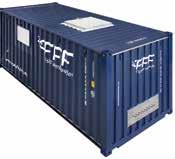
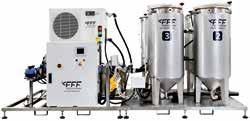
Ø Pipe 20 mm
Pre-grow
Pellet 1-4 mm
Ø Pipe 25-40 mm

Pellet 4-20 mm
Ø Pipe 50-90 mm

LAND • SEA • RAS Aquaculture
Feeding Systems
Live feed
Ongrowing
L A N D B A S E D L A N D B A S E D L A N D B A S E D S E A B A S E D Dry feed The only manufacturer worldwide that covers all feeding stages of fin fish and shrimp, for land or sea based systems Aquaculture Europe 2023 - Booths 16-17 18 - 21 Sept 2023 • Vienna (AUSTRIA)
and big data allow aquafarmers to address the complexities of weather, genetics, and market turbulence.
Lessons for the world of aquaculture
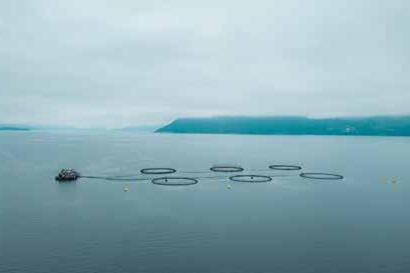
While robots, IoT, and AI systems have improved the healthcare sector, they have also resulted in job displacement on a large scale. This development can generate concerns about the future of employment, especially considering that the food system provides employment for a majority of people in developing countries according to the World Bank. This tech-driven transformation could also impact jobs requiring high skill levels. But as we’ve seen in hospitals, we don’t have fewer doctors, nurses or caregivers. Human labour has not been eliminated; the jobs humans fulfil have shifted. A similar transition is expected in the aquaculture industry.
In fact, technology in aquaculture offers solutions to many of the industry's most pressing problems. If professionals in the aquaculture field can learn from the digital transformation experienced by the healthcare industry, the implementation of robotics, sensors, and AI could lead to enhanced productivity and increased profitability.
What is the best way to prepare the aquaculture industry for these changes?
Retention and continuous investment in talent will be key. When hiring future professionals for the aquaculture industry, it will serve the business to recruit individuals with innovative
skills, such as data analysis, software engineering, coding, and robot maintenance.

As for retention, automation could help retain talent. Aquaculture employment in the U.S. has only increased by 0.5 percent from 2018 - 2023 and grew zero percent in 2023. Workers often leave aquaculture because of poor pay and difficult conditions. If automation takes over undesirable tasks, it could pave the way for more engaging, better-paid roles that draw and retain a flexible workforce.
Talent retention goes hand in hand with talent investment. As I noted in my book, The Future of Agriculture, education and training programs cultivate a diverse and flexible workforce that evolves with each innovation. Companies can strengthen their operations from the top-down through leadership development or from the bottom-up through employee training.
Robots, IoT and AI systems pose radical solutions to many of aquaculture's most pressing problems, and if aquaculture learns from healthcare and invests in the workforce now, these technologies could boost productivity and drive new levels of prosperity.
Has technology's transformative impact on the healthcare industry paved a roadmap for the ongoing transformation in aquaculture? By employing robotics, sensors, and AI to cultivate food with efficiency, precision, and cost-effectiveness, the aquaculture industry can provide safe and affordable food and address the sustainability concerns of consumers, climate change, labour and resource scarcity.
agritechcapital.com/books
Master in Sustainable
International Aquafeed - August 2023 | 19
Aquaculture
New generation extrusion system promotes an upgradation in aquatic feed production
by Garrick
With the advent of Industry 4.0 and the pervasive adoption of lean manufacturing practices across various industries, digitalisation has emerged as a prominent trend in recent years. In keeping with

the digital transformation, Famsun has developed a new generation of aquatic extrusion systems that are based on lean principles. These cutting-edge systems are designed to provide enhanced value to customers and exemplify Famsun's resolute commitment to actively respond to the demand for digital factories. In doing so, Famsun will become a veritable "engine" that drives the high-quality development of the
 Yan, the Supervisor, R&D Global Application Center & David Ma, Deputy Director, R&D Institute, Famsun, China
Yan, the Supervisor, R&D Global Application Center & David Ma, Deputy Director, R&D Institute, Famsun, China
20 | August 2023 - International Aquafeed
Figure 1: Control System User Interface
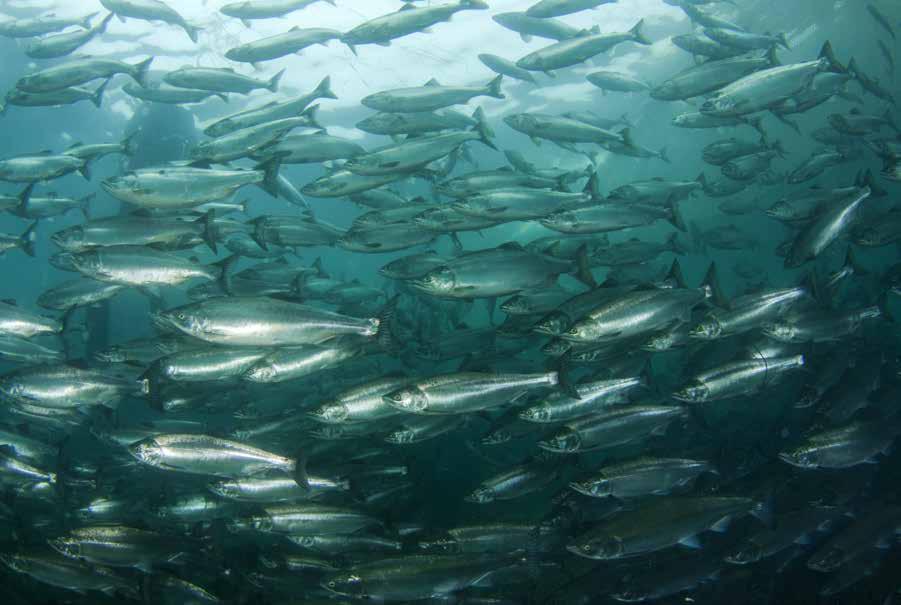






































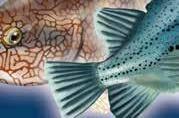
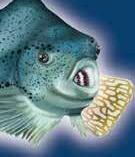

E ciently Precise control of product density for floating and sinking options Ingredient flexibility for all aquatic species High-capacity systems reduce operating costs Legendary Wenger quality, throughput, and flexibility Wenger extrusion systems are ideal for salmon, shrimp, and RAS feeds Wenger.com THE INNOVATIVE SOLUTION TO CLEANER FISH MANAGEMENT & SEA LICE CONTROL COMPLETE, TAILORED FEED BLOCK DIETS FOR LUMPFISH & WRASSE REDUCED IMPROVED Produced in the UK by www.vitaaquafeeds.uk • SEA LICE POPULATIONS • CATARACT PREVALENCE • AGGRESSION DURING FEEDING • ENERGY CONSUMPTION • STORAGE SPACE & COSTS • MEDICAL TREATMENTS • FISH HEALTH & WELFARE • MORTALITY RATES • STABLE, CONTROLLED GROWTH • LONGEVITY & EFFICACY • PRACTICAL FEEDING METHODS • DAILY OPERATIONAL COSTS International Aquafeed - August 2023 | 21
Make Higher Quality Feed More























































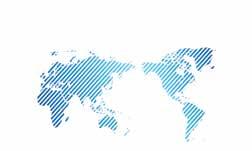
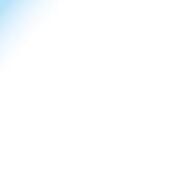
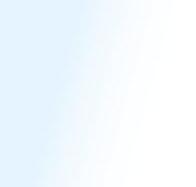










World Leaders in Microwave Moisture Measurement Hydro-Probe XT Hoppers, chutes, belt conveyors Hydro-Mix XT-FS Mixers, conveyors, Ducting System Hydro-Mix XT-EX Certified for use in ATEX, IECEx and NEC/CSA Hazardous Locations (Dust) Hydro-Mix HT-EX Mixers, conveyors, Ducting System, High Temperature Non Food-Safe available Non EX available Non EX available enquiries@hydronix.com Contact us for more details hydronix.com Hydronix-Aquafeed-Advert Mar 2023 210x146mm.indd 1 28/02/2023 09:58 www.ge-pro.de Animal proteins and fats as sustainable feed materials For more information, visit us online: VIV MEA 2023 ABU DHABI, U.A.E. 20-22 NOVEMBER INTERNATIONAL TRADE SHOW FROM FEED TO FOOD FOR THE MIDDLE EAST AND AFRICA WWW.VIVMEA.NL Register your visit now! Powered by: Co-located with: Organized by: VNU EUROPE WWW.VIV.NET Partner of 22 | August 2023 - International Aquafeed
Visualised production data
From a lean perspective, data-driven improvement is critical. However, numerous factories either do not collect production data or still rely on paper-based records. The value of this data is restricted due to inaccessibility, inconsistent readings, and the inability to analyse and use the data in real-time.

To tackle this issue, Famsun upgraded their control system. At first glance, key monitoring data such as pre-conditioning temperature, preconditioning retention time, melt temperatures and melt pressures before the die plate, main motor load, and SME are prominently displayed on the control panel, making it easier for operators to determine if production and safety requirements are being met.
The upgraded system surpasses mere data display and allows digital collection, standardisation, and real-time analysis to identify improvement opportunities. Automated alarms notify operators of deviations from set points to minimise waste and downtime. In summary, the digital control system helps transform data into actionable insights to drive continuous lean improvements.
FAMSUN Digital Extruder offers a visual data management platform containing various tools. Customised production reports automatically grab production data in real-time and generate daily, monthly, or annual reports according to the established template. The data sheet also has rich functions such as classification, sorting, filtering, and comparison, which can help the manager efficiently compare and analyse the data.


Moreover, in the new generation of digital extrusion system, we have added the function of maintenance reminder. The program has set up reminders and overdue alarms to facilitate maintenance personnel to arrange their work reasonably and avoid unplanned downtime caused by negligence in maintenance. Do not underestimated this small tool, according to the survey, the total maintenance cost with no plan is more than three times than has a periodic plan.
The production efficiency analysis module monitors and analyses equipment performance in real time. For instance, it can categorise the running status based on a combination of production parameters, then calculating the time spent and material usage at each status. The module also identifies the reasons for and locations of downtime and provides recommendations to improve production efficiency. This module clearly supports lean production teams by helping them analyse the root causes of inefficiencies and continuously improve key performance indicators like overall equipment efficiency (OEE) and yield efficiency (YE).
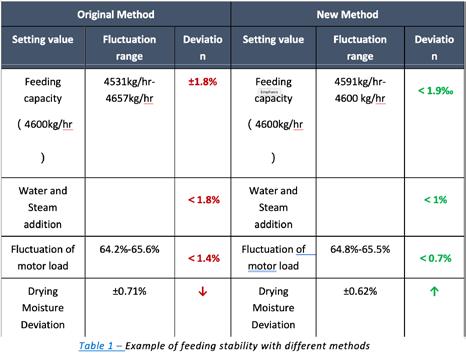
global
agriculture industry.
Figure 2: Customised Report and Data Analysis
Overall, the production efficiency analysis module aims to transform data from extruder operations into actionable information that can guide decisions for enhancing efficiency, yield and equipment utilisation through a lean lens. By presenting insights in a clear and easy-tounderstand manner, it can help extruder operators and managers make more informed choices to optimize operations on an ongoing basis.
Uniform quality comes from stable feeding
Stable and consistent feeding of dry and wet materials is paramount to the pellet uniformity and quality. Our team of control engineers have conducted extensive research on various operating conditions in different applications and have developed an advanced automatic feeding control program. This program precisely controls the feeding rates of dry and wet materials to maintain a consistent ratio during extrusion. It can compensate for fluctuations in raw material properties and machine variables, ensuring stable material flow into the extruder barrels. By monitoring sensors in real time and automatically adjusting feeder speeds, the control program reduces variations in pellet properties, responding quickly to maintain a uniform material mix and feeding rate under different operating conditions. Less variation in material feeding also helps improve the throughput and energy efficiency. In all, this upgrade not only satisfies the traditional requirement of automatically adding water and steam according to the proportion of dry materials to ensure constant moisture and temperature, but also significantly reduces motor load fluctuations and even decreases the moisture deviation in the finished product. For a 10-tonnes/hr single dryer, this improvement may increase profits by more than US$60,000 per year.
Reduce “ Start-up Waste”
Excessive startup waste is a major issue in extrusion production management. For instance, a typical 10-tonne-per-hour extrusion line can generate over 600 kilograms of startup waste every time it starts from cold. This not only wastes labor but also raw materials if the startup waste cannot be recycled and reused in time.
The startup waste reduction module aims to solve this problem as a unique technology in the industry. It aims to speed up the heating of the system and reduce the amount of waste generated during the initial run. For a standard aquatic feed production run, this technology can shorten the time to reach stable running conditions by more than 20 percent, reduce pre-conditioner startup waste by up to 70 percent, and reduce the total extrusion system's startup waste by over 60 percent.
The module achieves this through optimised control of heating elements, automatic adjustments to process parameters, and active monitoring of material flow and temperatures. It works to quickly bring the extruder barrel and the melt before die plate up to the stable operating temperatures while minimizing material
wastage. Therefore, the startup waste reduction module provides significant benefits in terms of material savings, production efficiency, and environmental impact. By optimising the system's warmup process, it helps maximize yield and productivity from the very beginning of each production run.
Additionally, after reducing the total waste, it is easier to reuse these materials in time. We have several processing solutions to recycle the remaining scraps, reducing labor intensity and avoiding material loss in all aspects, especially when changing the formula frequently.
Make all operations Easy
In order to consistently reproduce the qualified finished product, it is important to have a recipe management system (RMS) that stores the production data from successful runs. Famsun's RMS allows users to save all relevant parameters and recall them with one click.

This ensures that future productions using the same input materials and equipment status can match previous results. Users no longer need to manually re-enter settings each time.
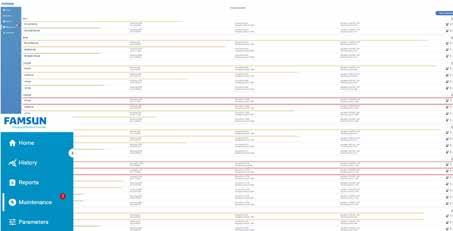
The RMS also features other integrated functions to simplify operations. These include one-click commands to flush the extruder, adjust jacket temperatures, and empty the conditioners.
In summary, the Famsun Digital Extrusion System integrates a stable feeding system, user-friendly control interface, functional modules and data analytics platform to embody the principles of reducing waste, recycling materials and reusing resources. This helps feed producers reduce costs, improve efficiency, optimise processes and produce consistent products of high quality.
Figure 3: Maintenance Warning
24 | August 2023 - International Aquafeed
Figure 4: Comprehensive efficiency analysis interface
RESTRICT inappropriate use of antibiotics and chemicals
REDUCE losses from subclinical disease and outbreaks
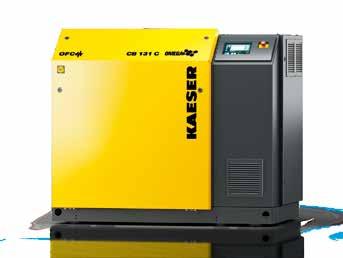
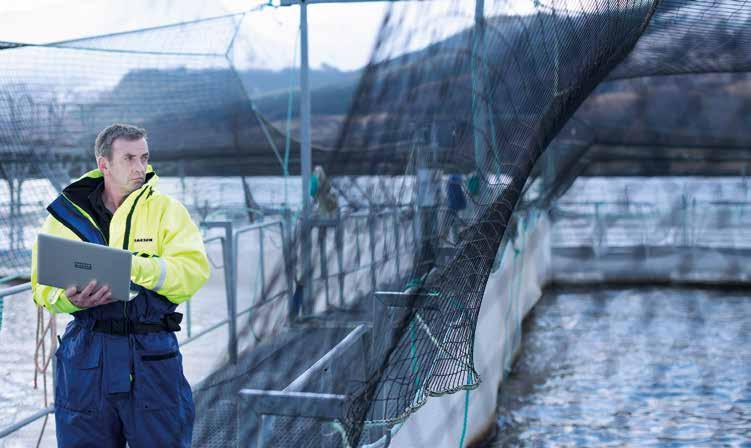
INCREASE economical and ecological sustainability
BOOST feed perfomance and farm productivity
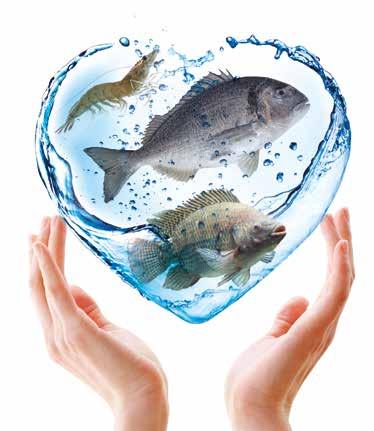
Aquaculture with KAESER reliable as the tides www.kaeser.com/aquaculture HEALTH IS AT THE HEART OF OUR CONCERNS
BOOST YOUR BUSINESS BY OPTIMIZING YOUR HEALTH ADDITIVE STRATEGY www.adisseo.com International Aquafeed - August 2023 | 25
Small adjustments for great benefits Boosting tilapia potential with organic trace mineral nutrition
by Claudia Figueiredo Silva, Zinpro Corporation, USA & Abdel-Fattah M. El-Sayed, Alexandria University, Egypt
The tilapia industry is a fast-paced and steady-growing aquaculture segment.
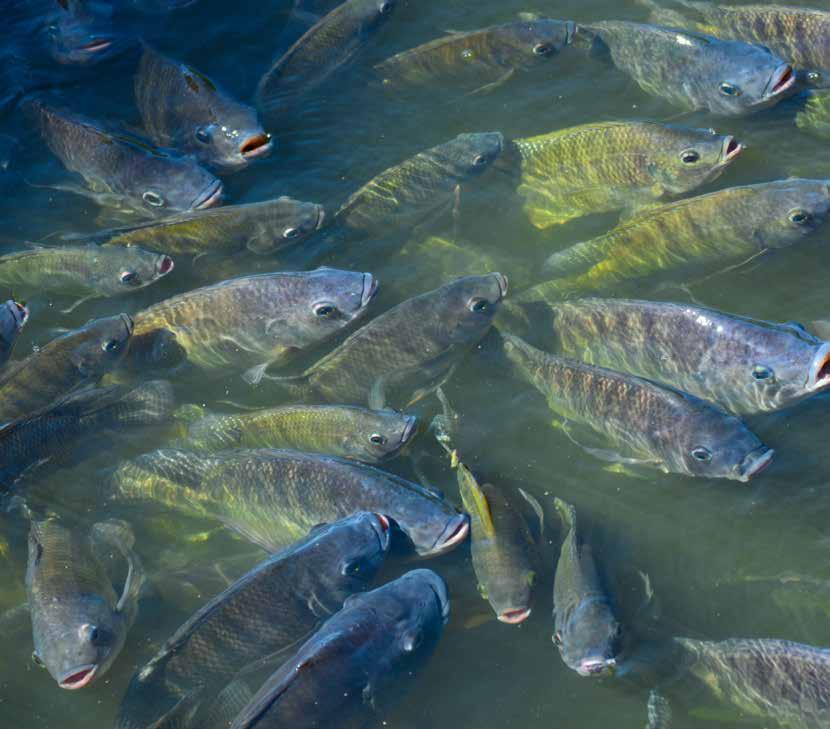
It has been a leader in developing new technologies such as advanced genetic lines, vaccines, production systems and feed technologies to continuously improve zootechnical performance and operational excellence.
When faced with challenging farming conditions, high-performing animals will have increased nutritional requirements and metabolic demands to grow and cope with environmental stress and pathogen pressure. Suboptimum diets may limit animals’ growth potential and curb their antioxidant and immune responses, thus increasing risks associated with health and diseases outbreak.
Trace Minerals (TM) in Tilapia Feeds Shouldn’t be Overlooked
Nutrients such as minerals and vitamins in practical fish diets are sometimes overlooked due to the priority focus on protein and energy, which are highly impacting feed costs. Trace minerals are involved in several metabolic functions related to fish physiology,
playing an essential role in the regulation of the innate immune system, digestive enzymes activity and antioxidant responses. By ensuring optimised absorption of these nutrients, animals can benefit beyond growth, expressing also a more robust health status and resistance to stress and pathogens.
Tilapia diets are usually formulated with plant-based protein meals including soybean, sunflower, cottonseed, peanuts, and then complemented with carbohydrates sources including wheat, rice, corn, etc. These ingredients are known to have low levels of essential TM, and low bioavailability due to the presence of antinutritional factors including phytates, saponins, glucosinolates, etc.
Traditionally, TM are supplemented in the feed to meet minimum nutritional requirements using premixes containing inorganic salts (e.g., sulfates, oxides). Inorganic TM are more likely to have low bioavailability to animals due to antagonistic interactions with other minerals and components in the feed and limited absorption sites in the intestine.
Organic minerals are metals bound to molecules such as amino acids, peptides, or carbohydrates to help facilitate their absorption in the gut. However, organic minerals behave differently, depending on the molecule they are bound with. Different molecules present different solubility, stability and
26 | August 2023 - International Aquafeed
resistance to stomach pH and extrusion process. Different molecules will also be absorbed and transported in the gut by different mechanisms, which impact their bioavailability.
The utilisation of highperforming organic minerals delivers superior responses compared to inorganic sources, an observation that has been scientifically proven in different species. Having validation under commercial field conditions is incredibly relevant, as it includes challenges to mineral absorption related to the water quality, environmental conditions, feed composition, etc., that aquaculture producers risk facing.
The Field Study: The Benefits of Proven TM Nutrition
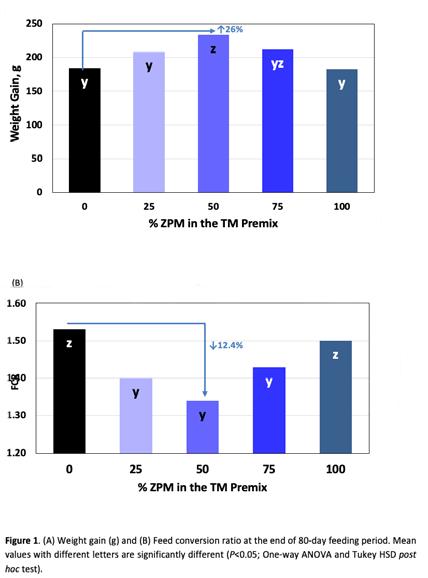
A trial was carried out in a commercial earthen-pond fish farm at Edku, Behaira Governorate, Egypt, to evaluate the effects of having metal-amino acid complexes of Zn, Se, Cu, Fe and Mn (Zinpro® Performance Minerals®; ZPM) replacing 25, 50, 75 or 100 percent of the inorganic TM premix in commercial diets for Nile tilapia (Table 1). Diets were formulated to be isonitrogenous (30 percent CP)
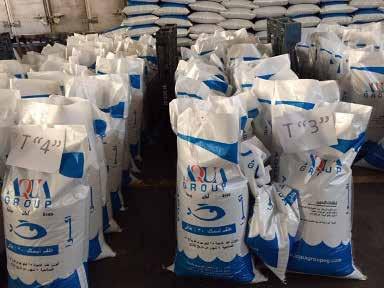




International Aquafeed - August 2023 | 27
and isoenergetic (17 MJ kg-1). The main protein sources and respective inclusions in the formula were soybean meal 38.5 percent, poultry by-product meal 5.5% and fishmeal 2.0%. The commercial diets were produced by Aqua International for Food Industries, Motobis Industrial Zone, Kafrel-Shaikh Governorate, Egypt.
Diets were fed twice a day for 80 days to quadruplicate groups of 90g monosex Nile tilapia (Oreochromis niloticus), stocked at a density of 30 fish/ m3 (60 fish/2m3 hapa). Average water quality parameters were: temperature 28.3 ºC (25.1 – 32.2ºC), dissolved oxygen 4.1 mg/L, water salinity 5-8 ‰ and ammonia 1.5 mg/L (0.4 - 2.4 mg/L).

Study Results: Improved Performance
• Replacement of inorganic TM with ZPM has significantly affected tilapia performance.
• The group with 50% of replacement reached the highest specific growth rate followed by the groups 75 and 25% (not significantly different from 50%).
• Groups fed ZPM at 50 and 25 percent had the highest final body weights, with no statistical difference from that fed ZPM at 75 percent (Figure 1-A).
• The control group (Inorganic TM)) had the lowest protein efficiency ratio with the highest feed conversion ratio (FCR).
• Improved FCR’s were observed in the groups fed ZPM at 25, 50 and 75 percent (Figure 1-B). at 50 percent replacement level, ZPM improved tilapia weigh gain and FCR by 26 and 12.4 percent, respectively.
• Digestive enzymes activities were significantly influenced by the replacement of inorganic TM with ZPM.
• The highest amylase, lipase and protease (trypsin) activity were observed in tilapia fed ZPM at 50 percent with an increase of
* Zinpro Performance Minerals, metal-amino acid complexes; zinc as Availa®Zn, iron as Availa®Fe, manganese as Availa®Mn, cooper as Availa®Cu and selenium as Availa®Se.
60.5, 98.4 and 176.2 percent, respectively, compared to the control group.
• Replacement of inorganic TM with ZPM significantly increased Se content in tilapia bone from +42 to +57 percent.
• Also, significantly higher Zn content was found in the bone of tilapias fed ZPM at 25 and 50 percent (34 and 24 percent higher compared to control group), and numerically higher in groups fed ZPM at 75 and 100 percent.
Organic Trace Minerals Drive Immunity and Gut Health Benefits
In the study, parameters related to gut health, antioxidant and immune response and gut microbiota were evaluated. Intestinal histology analysis revealed positive impacts of the replacement of inorganic minerals by metal amino acid complexes on increasing micro-villi length, reducing the inter-villi space and increasing the number of goblet cells in in the anterior gut, mid-gut and posterior gut.
Antioxidant system activity was significantly improved with higher activity of glutathione peroxidase (GPx) and superoxide dismutase (SOD). Similar effects were also observed on innate immune response such as lysozyme activity, respiratory burst, alternative complement pathway (ACH50) and phagocytic activity (Figure 2; submitted article). A positive gut microbiota modulation effect was also observed with significant increments in the total viable cells count and Bacillus spp and Lactobacillus spp. count. Furthermore, the count of potentially harmful bacteria such as Streptococcus spp. and Staphylococcus spp. were significantly reduced in the gut (Table 2).
Study Results: Profitability in Numbers
An economic evaluation revealed that all supplemented groups
TM
0,
Trace Mineral Source Trace minerals supplemental level (mg kg-1 feed) in
test diets 0 (Control) 25 50 75 100 Inorganic Zn (ZnO) 60.00 45.00 30.00 15.00 0.00 Zn-amino acid* 0.00 15.00 30.00 45.00 60.00 Inorganic Se ( Na2SeO3 ) 0.20 0.15 0.10 0.05 0.00 Se-amino acid* 0.00 0.05 0.10 0.15 0.20 Inorganic Cu (CUSO4) 10.00 7.50 5.00 2.50 0.00 Cu-amino acid* 0.00 2.50 5.00 7.50 10.00 Inorganic Mn (MnSO4) 30.00 22.50 15.00 7.50 0.00 Mn-amino acid* 0.00 7.50 15.00 22.50 30.00 Inorganic Fe (FeSO4) 100.00 75.00 50.00 25.00 0.00 Fe-amino acid* 0.00 25.00 50.00 75.00 100.00 Inorganic Cobalt (CoSO4) 0.10 0.10 0.10 0.10 0.10 Inorganic Iodine (Ca(IO3)2)* 1.00 1.00 1.00 1.00 1.00
Table 1: Trace mineral source and level supplemented to the different diets. Zinpro Performance Minerals replaced inorganic
at
25, 50, 75
or 100%
the
28 | August 2023 - International Aquafeed
delivered improved profit margins compared to the control group. The diet D50 generated the best contribution margin, 20 percent higher than control. FCR and biomass improvements generated sales revenues of 8.8 percent higher and reduced feeding costs by 3.4 cents of US dollar per kg of fish.

Trace minerals premixes inclusions in tilapia feeds usually ranges from 0.1% to 4.0% depending on the concentration and composition of the products, with cost contribution usually not exceeding 3 to 6 percent of total formula cost. In our study, formula optimizations increased formula costs marginally, with benefits outweighing by far the additional investments.
Conclusion: Investment in Trace Minerals Matters
Replacing inorganic salts of Zn, Se, Cu, Fe and Mn with Zinpro metal-amino acids complex in tilapia diets improves performance, health and economic results. Best recommendations from our regression analysis indicated optimum replacement of 50-55 percent for improved growth and 6065 percent for improved health status. Adopting advanced trace mineral technologies in aquafeeds is a critical step for the industry to promote performance with more efficient and sustainable diets.
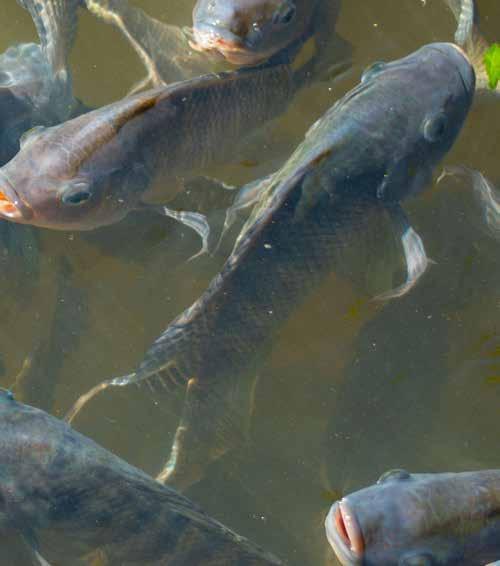
Partnership. Performance. Profit.
Something powerful happens when shared expertise, care and nutritional performance come together. Unrivaled solutions designed to advance your business forward. That is the transformational power of partnership.

Partner with us at zinpro.com #PowerOfZinpro

Performance replaced inorganic TM at 0, 25, 50, 75 or 100%. Bacteria genus 0(Control) 25 50 75 100 Total viable counts 4.4 ± 0.02w 5.3 ± 0.12yxc 6.2 ± 0.18z 5.69 ± 0.04y 5.0 ± 0.05x Bacillus spp. 1.4 ± 0.49y 1.9 ± 0.11y 3.1 ± 0.08z 2.27 ± 0.09zy 3.0 ± 0.06z Lactic acid bacteria 1.1 ± 0.08x 2.8 ± 0.08y 3.8 ± 0.04z 3.62 ± 0.18z 3.0 ± 0.07y Streptococcus spp. 2.1 ± 0.01z 1.8 ± 0.00y 0.1 ± 0.01 v 0.24 ± 0.02w 0.5 ± 0.05x Staphylococcus spp. 1.4 ± 0.02z 1.0 ± 0.02y 0.1 ± 0.02w 0.1 ± 0.01xw 0.1 ± 0.01w
Table 2: Microbiota analysis (log CFU g-1) in the tilapia gut. Total viable count, Bacillus spp., Lactic acid bacteria, Streptococcus spp. and Staphylococcus spp. Zinpro trace
International Aquafeed - August 2023 | 29
and its benefits in shrimp feed
by Jyothsna Nelloolichalil, International Aquafeed, UK
As the global demand for seafood continues to rise, the aquaculture industry faces increasing pressure to find sustainable and efficient methods of producing seafood. Shrimp farming, in particular, has gained significant popularity in recent years, but it is not without its challenges. One major concern is the environmental impact of shrimp feeds, which often rely heavily on fishmeal and fish oil derived from wild-caught fish stocks. To address this issue, researchers and industry experts are exploring alternative feed ingredients, and one promising candidate is seaweed.
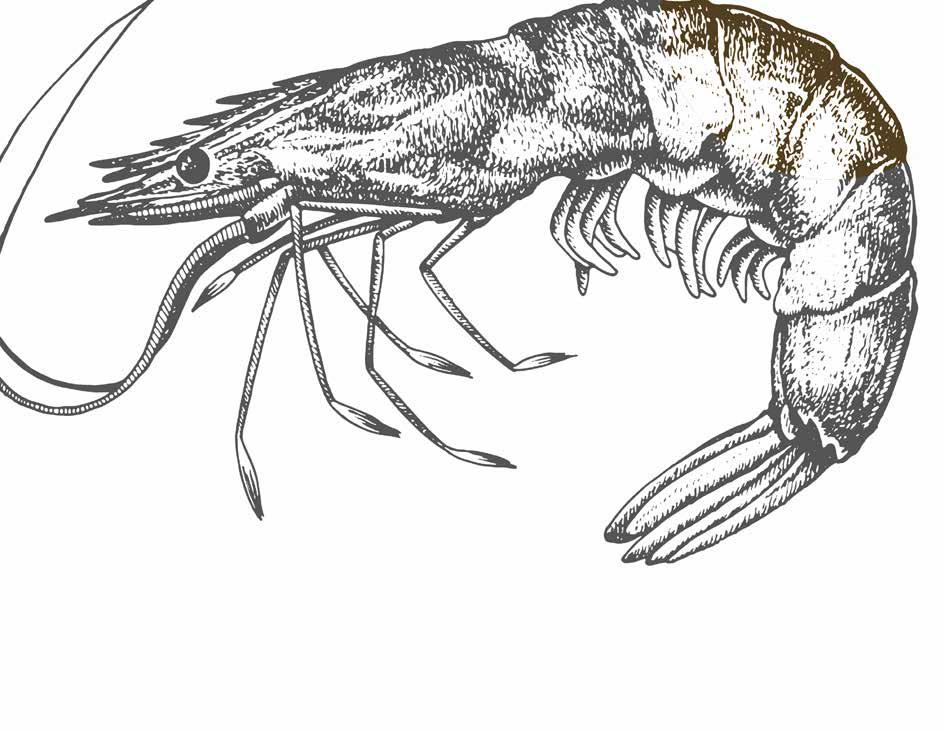
Seaweed, also known as macroalgae, is a diverse group of


marine plants that grow in coastal and oceanic waters. It is a highly sustainable resource that does not require fresh water, fertilisers, or pesticides to grow, making it an attractive option for reducing the environmental footprint of aquaculture operations. Additionally, seaweed cultivation can help mitigate climate change by absorbing carbon dioxide from the atmosphere and releasing oxygen through photosynthesis.
Including seaweed in shrimp feeds offers several potential benefits. First and foremost, seaweed is a rich source of essential nutrients such as proteins, amino acids, vitamins, minerals, and omega-3 fatty acids. These nutrients are vital for shrimp growth, reproduction, and overall health. By incorporating seaweed into their diets, shrimp farmers can provide a nutritionally balanced feed that supports optimal growth and reduces the reliance on fish-based ingredients.
30 | August 2023 - International Aquafeed
Brown seaweed in shrimp feed
A team of researchers at Federal University of Santa Catarina has recently studied the benefits of using brown seaweed in shrimp feed and examined the growth, gut development, disease resistance and digestive enzyme activity. The study showed that the gut epithelial surface used for nutrient absorption were increased in the diets with the lowest levels of seaweed.
Recently is Brazil, the shrimp production has been in decline due to white spot disease, and among the scientific community there has been interest in using seaweed in shrimp feed due to their properties such as nutritional elements, antiviral and

the effects of seaweed in juvenile shrimp and the results were promising. In juvenile shrimp, it improved both weight gain and feed efficiency, reducing production costs. OceanFeed Aqua also helped reduce mortality in a disease challenge trial run in parallel. Moreover, studies have shown that including seaweed in shrimp feeds can improve the overall feed efficiency and immune response of the shrimp. Certain compounds found in seaweed, such as polysaccharides and bioactive peptides, have been shown to enhance the shrimp's immune system, making them more resistant to diseases and reducing the need for antibiotics or other medical interventions. This not only benefits the
Legal business advice:
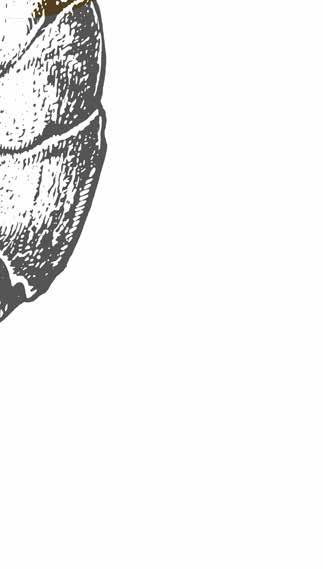
• Mariculture and Aquaculture leases
• Aquaculture and mariculture disputes
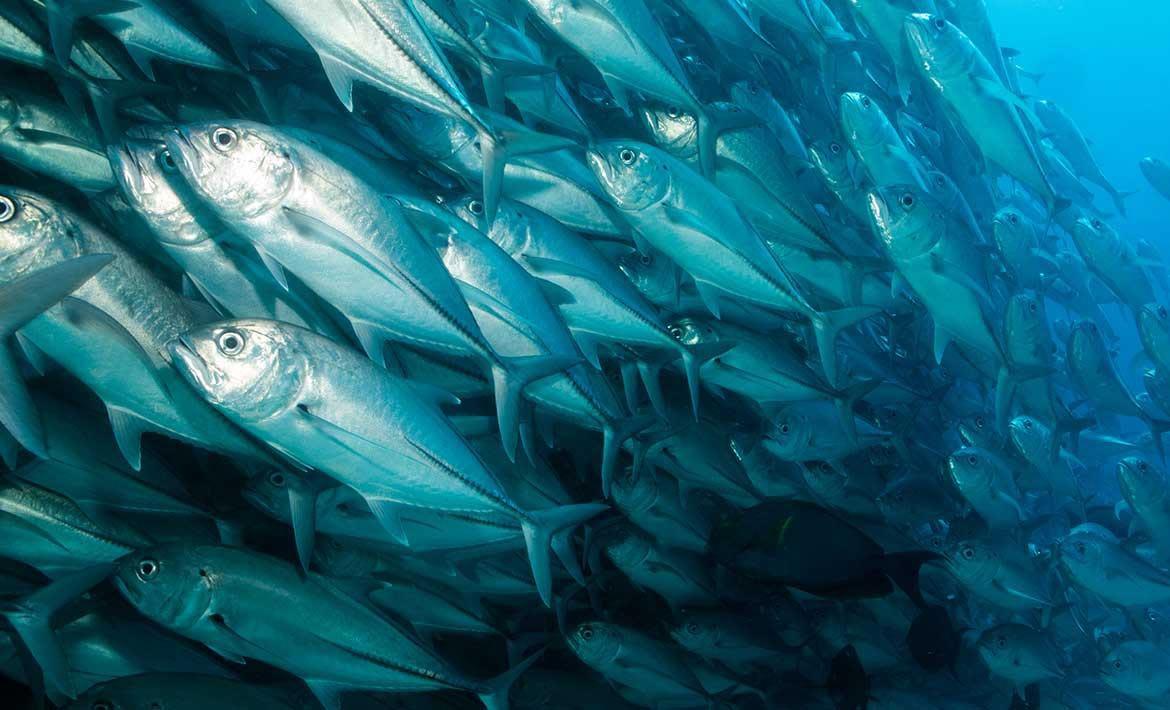
• Commercial fishery issues
• Acquisition and ownership of fisheries
• Registration of fishing rights
• Defence of fisheries prosecutions
• Seizure of fishing vessels
• International fishing licenses
• High seas fishing
WWW.AQUARIUSLAWYERS.COM.AU +61 (02) 8858 3233
International Aquafeed - August 2023 | 31
Great upgrade of your feeds!
In addition to its nutritional and health benefits, seaweed has the potential to reduce the environmental impact of shrimp farming. As mentioned earlier, fishmeal and fish oil production for shrimp feeds often involve the overexploitation of wild fish stocks, leading to ecosystem disruptions and depletion of marine resources. By substituting a portion of fish-based ingredients with seaweed, shrimp farmers can help alleviate the pressure on wild fish populations and promote a more sustainable seafood industry.


While there are numerous benefits to incorporating seaweed into shrimp feeds, there are still challenges to overcome. One of the main hurdles is the cost and availability of seaweedderived ingredients on a large scale. Currently, seaweed production is not as developed as other feed ingredients, and the industry would need to scale up cultivation, processing, and supply chains to meet the demand. Additionally, further research is needed to optimize the inclusion levels of seaweed in shrimp diets and ensure that it does not negatively affect shrimp palatability or digestive efficiency.
In other feeds
Decline in fish meal and oil for aquafeed production has necessitated the need for other alternative feed ingredients to supply the lipids and protein in the feed. Seaweed is great alternative as they are rich in minerals, essential fatty acids, protein and fibre with trace amounts of vitamins. In addition, seaweeds are available throughout the year and are easy to harvest. Furthermore, seaweeds are already in use as a natural food to fish in the wild. With these promising characteristics, seaweeds may be harnessed to promote fish growth and sustainability of aquaculture. Therefore, the objective of this review was to assess the potential use of seaweeds as a fish feed ingredient with emphasis on tilapia fish feeds.
In conclusion, seaweed holds great promise as a sustainable and nutritious ingredient for shrimp feeds. Its environmental benefits, nutritional value, and potential to improve shrimp health make it an attractive alternative to traditional fish-based feeds. However, more investment in research, innovation, and infrastructure is needed to fully realize the potential of seaweed as a feed ingredient. By embracing this renewable resource, the aquaculture industry can move towards more sustainable shrimp farming practices while meeting the increasing global demand for seafood.
Pole Position!
Cefi ® pro Autolyzed brewers’ yeast | Rich in nutrients and active ingredients | High bioavailability of the same | Stimulates the metabolism | Promotes feed intake and performance Visit our website: leibergmbh.de Leiber GmbH | Hafenstraße 24 | 49565 Bramsche Germany | info@leibergmbh.de 070223_Leiber_Anzeige_International Aquafeed_90 mm x 270 mm + 3 mm Beschnitt.indd 2 07.02.23 11:01 32 | August 2023 - International Aquafeed
SETS THE STANDARD IN SQUARE SILOS

Location: Wesley Vale, Tasmania, Australia
Product: Aqua feed: Dosing
www.tsc-silos.com Check out our references:
Capacity 2.900 m³ Bins 36 Height 29,8 m Width 12 m Length 20 m
“In Tasmania, they had plans to convert a former cardboard factory into a fish feed factory. And so it happened.”

Let’s talk possibilities » Considering your next move? We’re listening. www.ottevanger.com As industry experts, we fully understand the unique challenges you face in the aquafeed industry. That’s why we are committed to assist you throughout the entire journey, from concept to complete installation. Ready to reinvent your aquafeed operations? Skretting, Norway
The tech update
Biomaterial-based ropes
AZTI (Spanish scientific and technology centre)
The use of traditional plastics in aquaculture processes might be greatly reduced with the development of new biomaterial-based ropes. According to the Spanish scientific and technology centre AZTI, the carbon footprint of ropes made from biopolymers might be reduced by 34% when compared to ropes currently used in shellfish or algae aquaculture. The efficiency of the bio-ropes appears to be nearly comparable to that of conventional plastic ropes, according to testing, but they may have an edge in terms of the environment. “It’s an aspect of decarbonizing aquaculture,” said Leire Arantzamendi, a senior researcher with AZTI. “They are also compostable at the end of life, so that’s another advantage compared to the fossil-based ones, as they usually end up in the landfill or an incinerator, which puts more and more CO2 in the atmosphere.” While further testing is required to find out if the bio-ropes will be recyclable, they have determined that they are compostable at an industrial scale.

FISH FARMING
Welcome to 35 | August 2023 - International Aquafeed
TECHNOLOGY
Remote control Feed remotely from anywhere on earth
by Krucial, Scotland, UK
In the rapidly evolving field of aquaculture, where the demand for sustainable seafood continues to soar, innovative solutions are essential for meeting the world's growing appetite. One ground-breaking technology that has captured the attention of researchers, farmers, and conservationists alike is remote feeding technology. With its potential to revolutionise traditional feeding practices in aquaculture, this cutting-edge approach offers a promising pathway towards improved efficiency, enhanced sustainability, and increased profitability.
Aquaculture, often referred to as fish farming, has emerged as a vital industry to address the global seafood demand while reducing the strain on wild fish populations. However, conventional feeding methods in aquaculture have their limitations. Manual feeding, though widely practiced, is prone to inconsistencies and inefficiencies, leading to uneven growth rates, excessive feed wastage, and potential environmental pollution. Recognising the need for a more precise and controlled feeding
approach, experts have turned to remote feeding technology as a game-changing solution.
Remote feeding technology leverages advanced systems, such as sensors, cameras, artificial intelligence (AI), and automation, to monitor and regulate the feeding process in aquaculture operations. By removing the physical presence of feeders and allowing remote control, this technology enables fish farmers to optimise feeding regimes with unparalleled precision. Real-time data analysis, coupled with intelligent algorithms, empowers farmers to determine the ideal feeding quantity, frequency, and timing, tailored to the specific needs of the aquatic organisms.
A new technology to feed remotely from anywhere on earth
Satellite-enabled communication specialist Krucial has announced its cutting-edge new technology which will make it
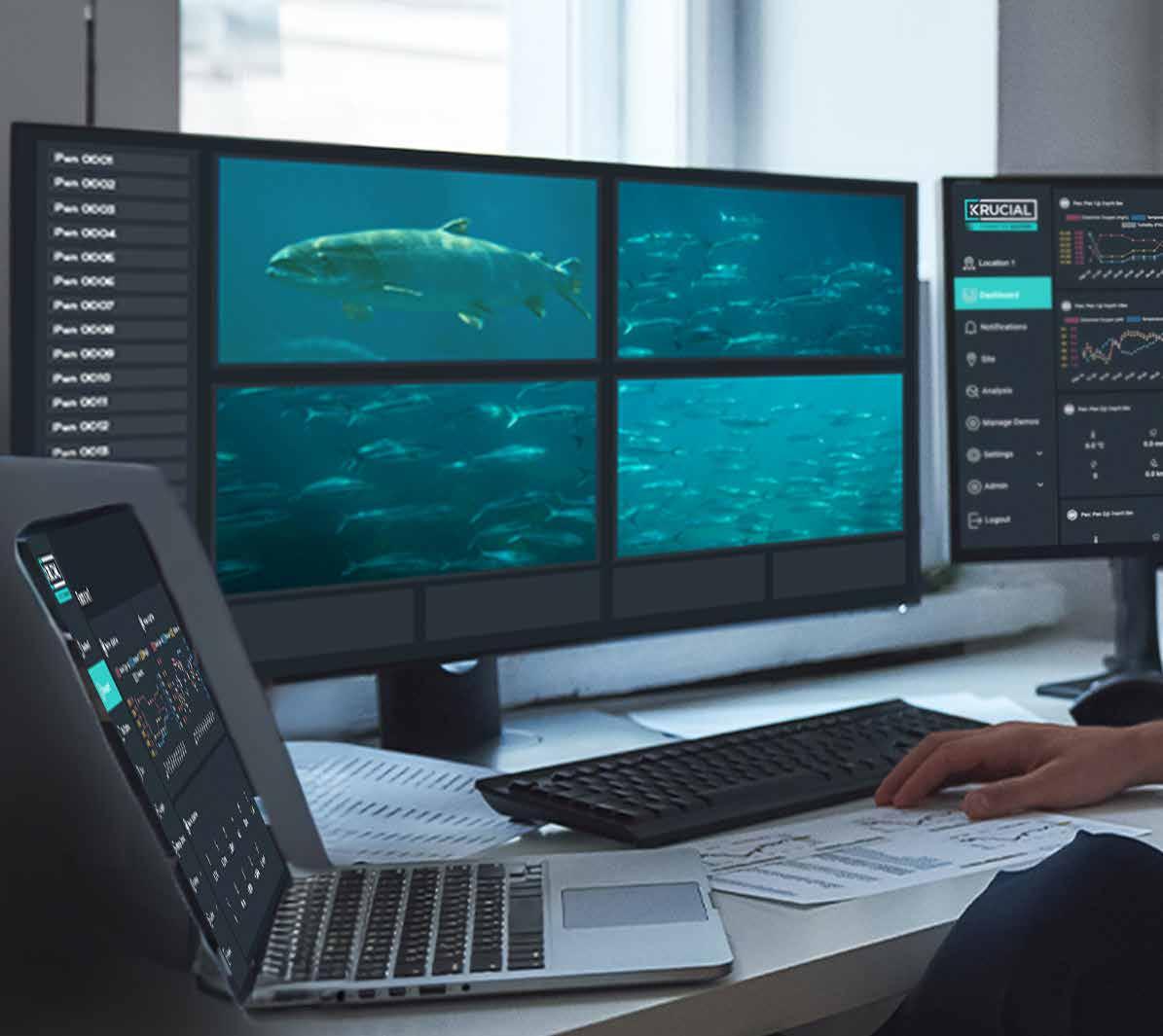
FISH FARMING TECHNOLOGY 36 | August 2023 - Fish Farming Technology
possible for operators to remotely obtain mission-critical feeding and environmental information they need from anywhere on earth.
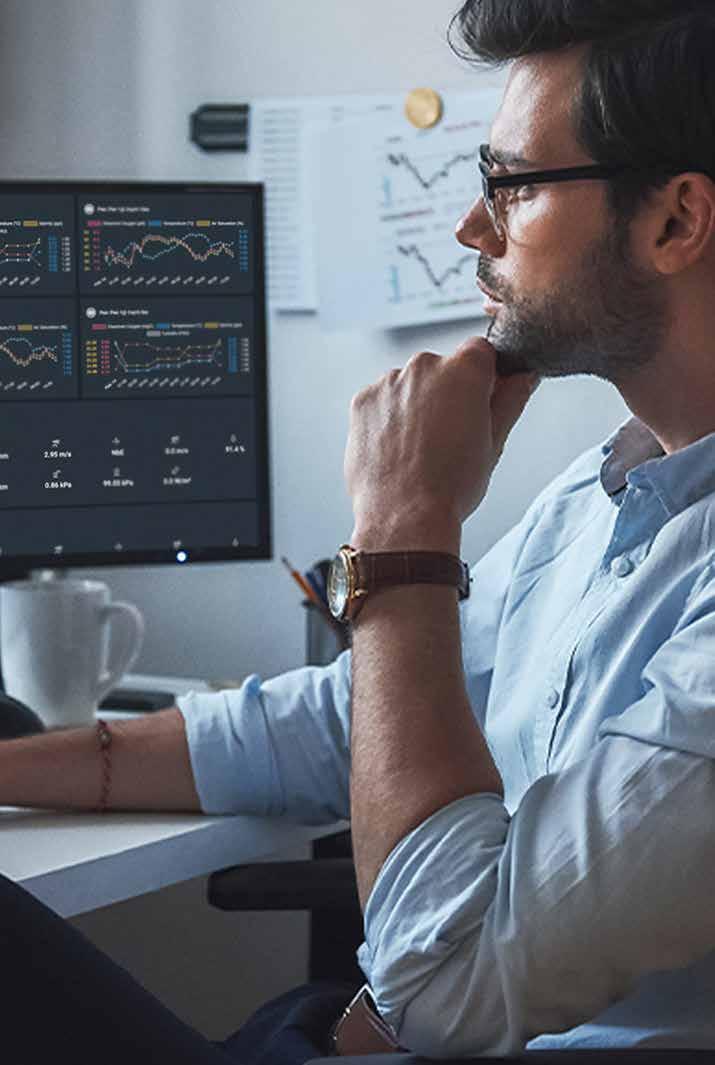
Using the new solution, fish farmers can get a continuous video stream from pens in areas even with no cellular connectivity or power and feed individual pens remotely using their desktop or mobile based on the insights received. Using the latest satellite technology, with auto adjusting flat panel antennas, means that barge movement does not impact the technology’s usability, offering an advantage over ‘line of sight’ solutions. If a farm is off the west coast of Scotland or Ireland, for example, and the operator is onshore or even thousands of miles away, they’ll be able to monitor fish behaviour continuously and feed with the click of a button.
The latest addition to Connected Seafarm provides the final piece of what is now a complete solution that incorporates remote feeding enablement, algae detection, environmental monitoring, barge telemetry and asset condition management. Krucial is now looking to work with partners to pilot the new technology in the field. Currently, poor connectivity on many fish farms makes remotely understanding fish behaviour challenging. This can
Pellet Durability Tester
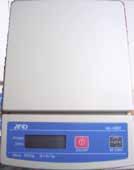
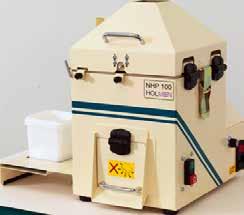

FISH FARMING TECHNOLOGY NHP100
*Place your order for an NHP100 Portable Pellet Durability Tester between 1st June and August 31st 2023, and receive the optional Digital Scales Absolutely FREE!^ ^Visit for full details of this offer. www.tekpro.com/specialoffers
impact decisions around exactly how much feed to distribute to sustain fish and maximise their welfare while minimising waste. Krucial’s solution will enable farmers to feed remotely from anywhere on earth – meaning during extreme weather or when other tasks come up, staff resource can be optimised. Given the significant cost of feed to the sector, the ability to optimise feeding can contribute to cost savings as well as the management of ocean impact.
Kevin Quillien, Co-founder and CTO of Krucial, said: “This is a huge step forward for Krucial and our offering to the aquaculture industry. We are confident that with our new capabilities we are providing fish farmers with the ultimate tool in understanding what’s happening at their farms –ranging from fish behaviour to water quality to equipment conditions.
“Farmers can now sit at home or in the office, with all the information they need at their fingertips to take quick action that boosts efficiency and sustainability and reduces riskeven at their most remote and inaccessible sites.
“Aquaculture is on a mission to feed the world sustainably and this tool makes that job much easier, saving the industry time and money while benefitting the environment. We are looking forward to working with early adopters in the coming months.”


The new solution will transmit high bandwidth video data over cellular or satellite, whichever is available. If the primary satellite fails, a secondary satellite kicks in to maximise resilience. This means that even in extreme weather or further offshore, where connectivity has traditionally been an obstacle, farmers still have
More benefits
The benefits of remote feeding technology extend beyond precise and efficient feeding practices. Environmental impact reduction is a crucial aspect of this technology. By minimizing feed waste and limiting nutrient release into surrounding ecosystems, remote feeding technology can significantly mitigate water pollution and the associated negative ecological consequences. Additionally, remote feeding reduces the need for human intervention, diminishing occupational hazards and creating safer working environments for aquaculture professionals.
Moreover, the economic advantages of adopting remote feeding technology cannot be overlooked. The ability to optimize feed usage reduces production costs, while maximizing growth rates enhances overall productivity and profitability. With remote access and monitoring capabilities, fish farmers can efficiently manage multiple sites and reduce travel expenses. This technology also holds immense potential for remote or offshore aquaculture operations, where physical presence and accessibility pose significant challenges.
As we navigate the frontiers of aquaculture innovation, remote feeding technology stands out as a beacon of hope, offering a path towards a more efficient, sustainable, and economically viable future. Join us as we unravel the intricacies of this revolutionary technology and unveil its immense potential in reshaping the aquaculture landscape. Krucial is actively engaging with a number of aquaculture operators about a series of pilots over the next few months – t o find out more about this opportunity, get in touch at contact@
FISH FARMING TECHNOLOGY 38 | August 2023 - Fish Farming Technology












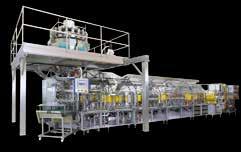
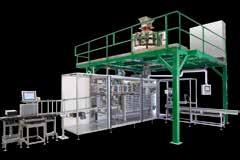
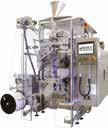
The Packaging Group GmbH Gerberstraße 50 · 51789 Lindlar, Germany · www.the-packaging-group.com If you can think it we can pack it The Packaging Group (TPG) Visit our NEW YouTube channel and find your perfect fish food packaging solution HDG RB-600 FAWEMA FA 456 WOLF VPC
TECHNOLOGY SHOWCASE


Innovations this month August 2023

In this dedicated Tech Showcase section of the International Aquafeed Magazine, we showcase technologies that are reshaping the way we approach aquafeed production and aquaculture practices by revolutionising feed production, fish health, and sustainability. If you would like your product or service to appear in this section in a future edition of International Aquafeed and Fish Farming Technology magazine, then please contact us at editorial@perendale.co.uk

The Flobull aerator by Faivre
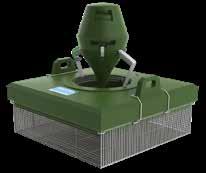
The Flobull aerator projects a very emulsified spray of water into the air, thus providing maximum contact with the atmosphere. In this way oxygen in the air is transferred into the water. This process does not raise the water temperature because a sometimes warmer atmospheric contact is compensated through cooling caused by evaporation.
Despite their low electricity consumption, 180W to 1500W, Flobulls have a water mixing flow rate of 75 to 380m3/h. For a Flobull 1CV (750W), the high oxygen input into the water is 1.2kg of O2/h. Fish grow up in the best conditions withe Faivre aerators. They are useful to Oxygenate water and discharge gases, diffuse the recycled water through the pond and help a regular growth of your fish. Since the 1960’s, FAIVRE has been developing floating aerators. www.faivre.fr
AQ and OC sensor series by ANB sensors
ANB Sensors the creator and manufacturer of a revolutionary and ground-breaking pH sensor technology, that requires no calibration, announced their range of AQ and OC Series sensors are fully released.

With 4 models to choose from the AQ5 & AQ50 models operating to 5m and 50m depths respectively are ideally suited to the demands of aquaculture, including RAS facilities, well boats, and ferry box applications. Whilst the OC300 & OC1250 operate to deeper depths of 300m and 1250m, for coastal, oceanography, and UAV deployments.
“Based on feedback from the extensive trials of our previous “S” series sensors, the new AQ & OC sensors are delivering all the features that have been requested by our customers”. said Nathan Lawrence, CEO of ANB Sensors. “We have a strong product roadmap and will be releasing many new features via firmware releases, all based on the existing hardware platform.” www.anbsensors.com
TwinLab-F 20/40 by Brabender
The TwinLab-F 20/40 scores highly due to it being a compact extrusion solution with integrated drive. This space-saving and economical solution texturises the widest range of different materials. Develop new formulas and standards or simulate processes exactly to scale. It is a standalone solution for food extrusion at lab scale as it modifies and texturise various materials, such as for example proteins, starch, fish feed, cereals and pasta.
With a rotational speed of up to 1200 rpm, this extruder offers the user greater flexibility when it comes to energy input and throughput. What’s more, the cylinder is split horizontally and is hinged at both sides, which makes the segmented screws easily accessible. The sample is inserted and then extruded by the twin-screw extruder. During the analysis, sensors and controllers measure relevant values, such as temperature and pressure. www.brabender.com

Learn more – Learn onsite Enroll in the 12-week Course
FISH FARMING TECHNOLOGY Check out our website dedicated to fish farming technology
SHOWCASE
FaunaGuard by AceAquatec
If the proper precautions are taken, marine construction activities need not cause deafness or other serious physical harm to local wildlife.
FaunaGuard is a modular system that uses academically validated sound patterns with award-winning acoustic transducer technology to create temporary exclusion zones around a project site.
FaunaGuard is an innovative suite of devices that use modern acoustic techniques to remove marine fauna from active construction zones. Each module is purpose-built for a target species to create temporary clear zones around a project site.
FaunaGuard’s modular design means that it can be tailored to the specific needs of each target species - fish, seals, porpoises, or turtles. Its state-of-the-art acoustic technology makes optimal use of an animal’s hearing range and sensitivity.
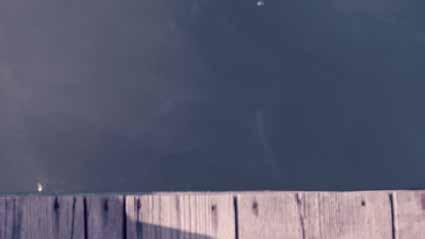
The remote monitoring and control portal provides an easy-to-use interface for checking the effectiveness of the system.

www.aceaquatec.com

Hydro-Probe by Hydronix
The Hydro-Probe was the first moisture sensor to use the digital microwave moisture measurement technique. It has integral signal processing which provides a linear output (both digital and analogue) and it can easily be connected to any control system. Typical applications include sand, cement, concrete, asphalt and aggregates. For organic materials the Hydro-Probe XT is recommended.
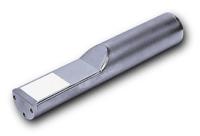
Designed for use in processing plants which use bins (silos), chutes and conveyor or feed belts, the sensor is positioned into the flow of material. Measurements are taken 25 times per second as the material passes over or around the sensor face, meaning that the sensor can rapidly detect changes in moisture levels. Real time adjustments to the moisture content of the material can then be made during processing if required. This ensures that the manufacturer can continually produce a consistent, quality product and reduce costs by limiting the amount of wasted or spoilt materials.

www.hydronix.com


www.onlinemillingschool.com
fishfarmingtechnology.net International Aquafeed - August 2023 | 41
Sablefish Aquaculture:
Aquaculture projects in the Pacific Northwest
Sablefish farming trials are being conducted by scientists at the NOAA Fisheries Northwest Fisheries Science Centre in an effort to establish a sustainable commercial aquaculture sector in the United States. However, because of the high expense and difficulties involved in reproduction, larval rearing, and grow-out to harvest size, sablefish, like many marine finfish species, can be difficult to produce and develop on a commercial scale.
Improving Rearing Practices, But Challenges Remain
Scientists at the science centre have been working on technology to culture sablefish from eggs to adults in order to better understand their biology and life cycle for more than ten years.
Starting with wild broodstock, sablefish are cultivated. The eggs are collected, fertilised in vitro, and then moved to incubators with environmental controls. At the Manchester Research Station in Port Orchard, Washington, they are raised in tanks through the larval and juvenile stages after hatching before being transferred to net pens.
To save expenses and boost productivity, our researchers' and their associates' work has significantly enhanced rearing techniques. For instance, they have shortened the larval rearing phase by improving tank design and raising temperatures. Additionally, they used clay instead of algae to create opacity in the larval rearing water instead of algae since it was a less expensive option.
Additionally, centre researchers have created non-GMO methods to raise all-female sablefish stocks for aquaculture. The term "monosex" refers to a population that is exclusively male or exclusively female. These monosex female sablefish stocks grow at a pace that is noticeably faster than stocks with slowergrowing males.
Making sablefish aquaculture a successful commercial

Black cod, often known as sablefish, is a delicious, buttery fish that is highly prized in the fishing industry. Although they are responsibly maintained, there are fewer of them in the wild than in the past, and fisherman are harvesting less of them.
enterprise still faces difficulties. Although scientists have solved numerous technological obstacles, major societal and bureaucratic barriers still exist. For instance, significant challenges include finding organisations prepared to invest in the infrastructure required to sustain commercial-scale production and obtaining permissions to grow fish in net cages.
Transferring the Latest Technology to the Jamestown S'Klallam Tribe
The scientific centre, the Jamestown S'Klallam Tribe, and most recently the University of Washington (with assistance from Sea Grant) have all been testing the growth of sablefish in net pens since 2014. In order to start large-scale, commercial activities in the United States, this alliance wants to develop and impart expertise and technology to the tribe.
Researchers recently put monosex female sablefish fingerlings in the net pens at the Manchester Research Station as part of a collaboration with the Jamestown S'Klallam Tribe and Cooke Aquaculture Inc. The fingerlings were grown to commercial size over a period of around 18 months by staff from the scientific centre and the Jamestown S'Klallam Tribe.
Study participants evaluated the development and health of sablefish. In the pens, they also monitored environmental factors like the temperature and the oxygen levels. In order to check for environmental implications, partners from the University of Washington studied how the net pen grow-out affected the sediments beneath and around the pens.
The markets for this product are still expanding, but they were some of the first cultivated sablefish taken in the country. The alliance is still working on the technical components and laying the basis for Native American tribes and other interested parties throughout the U.S. West Coast to raise sablefish in net pens.
Aquaculture case study
CS 42 | August 2023 - International Aquafeed


























































































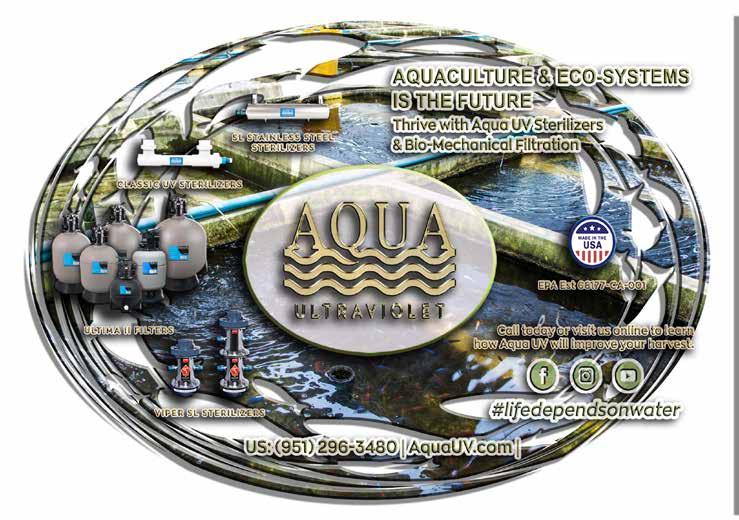
CS International Aquafeed - August 2023 | 43
Industry Events
Status updates for industry events amidst global effects of COVID-19

2023
2023 August
23-25
Aqua Nor
Trondheim, Norway
https://aquanor.no


31 - 2
Taiwan International Ocean and Fisheries Industry Show (TIOFIS)

Taiwan
www.taiwanagriweek.com
2023 September
6 - 7
Seagriculture uSA 2023
Portland, USA
https://seagriculture-usa.com
6 - 8
Expo Pesca AcuiPeru
Lima, Peru
www.thaiscorp.com
11 - 13
Seafood Expo Asia
Singapore
www.seafoodexpo.com
18 - 21
Aquaculture Europe
Vienna, Austria
www.aquaeas.org
2023 October
3-5
Pet-Aqua Conference


São Paulo, Brazil
https://victamlatam.com
October 3-4, 2023 São Paulo Brazil
Two half-day conferences for millers
5 FEED MILLINg MAXIMISED Conference


São Paulo, Brazil millingandgrain.com/event /feed-milling-maximised-2023
MAXIMISED FEED MILLING 20


October 5th, 2023
A CONFERENCE FOR FEED MILLERS São Paulo, Brazil
11 - 13
Aquaculture Vietnam 2023 Ho Chi Minh City, Vietnam https://aquafisheriesexpo.com

23-25
Victam LatAm Sao Paulo, Brazil. https://victamlatam.com
23 - 26
Aqua Expo 2023 Guayaquil, Ecuador https://aquaexpo.com.ec




2023 November
1 - 3
Aquaculture Taiwan Taipei, Taiwan, www.aquaculturetaiwan.com
13- 16
AFRAQ - Aquaculture Africa Lusaka, Zambia www.was.org

14 - 17
Fenacam
Natal, Brazil
www.fenacam.com.br
20 - 22
VIV MEA 2023 Abu Dhabi
www.vivmea.nl
19
Aquaculture Extrusion & Nutrition Conference



Abu Dhabi, U.A.E. bit.ly/aenc23
Aquaculture development and investment


Aquafeed Extrusion and Nutrition Conference will be held at VIV MEA 2023. It is a one-day conference centred on the topics of the production and extrusion of aquatic feed along with the nutrition and farming for fish and shrimps. Covering a variety of topics within aquafeed, this conference will provide knowledge, solutions, and research for everyone in the aquaculture.


To sponsor please email:
Tuti Tan – tutit@perendale.co.uk


For more information on the conference please email: Shannon Parsons – shannonp@perendale.co.uk
2023 December
12 - 15
AlgaEurope 2023 Prague https://algaeurope.org
3 The Online Milling School LIVE! São Paulo, Brazil
www.onlinemillingschool.com

23
Live session: October 3, 2023 São Paulo Brazil TRAINING FOR MILLERS www.onlinemillingschool.com ☑
this
44 | August 2023 - International Aquafeed
See The International Aquafeed team at
event


















































VIV TÜRKİYE 2023
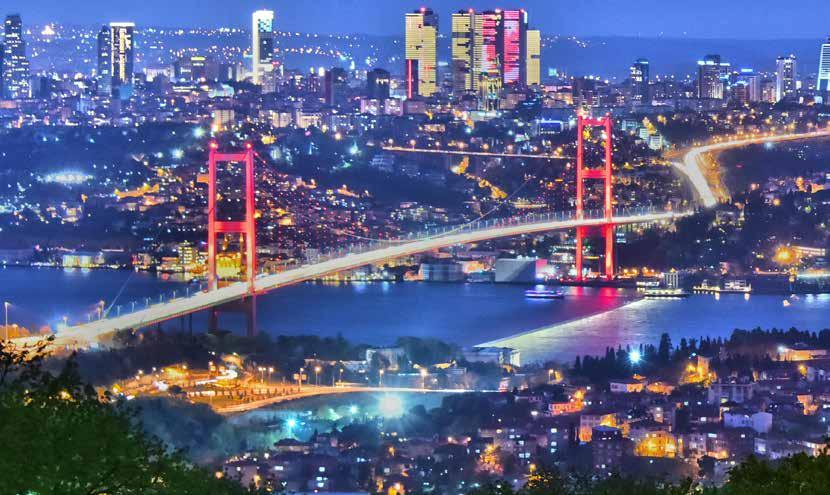 By Mehmet Uğur Gürkaynak, International Aquafeed, Türkiye office
By Mehmet Uğur Gürkaynak, International Aquafeed, Türkiye office
VIV TÜRKİYE, the focal point of the feed industry opened its doors for the 10th time with the organization of HKF Trade Fairs under the license of VNU Exhibition Europe on July 6th in Istanbul Expo Center. This year the fair hosted more than 281 companies and more than 15,000 buyers came as visitor from the poultry sector.

10th International Trade Fair for Poultry & Technologies VIV TÜRKİYE 2023 was officially opened following the speeches of Ahmet Yavuz Karaca, Director of Istanbul Directorate Of Provincial Agriculture And Forestry, Prof. Dr. Rüveyde Akbay, President of World’s Poultry Science Association (WPSA) Turkish branch, Naci Kaplan, Chairman of Association of Poultry Meat Producers and Breeders, M.Ülkü Karakuş, Chairman of Turkey Feed Manufacturers Association, İbrahim Afyon, Chairman of Turkish Egg Producers Association, Prof. Dr. Pınar Saçaklı , Chairman
of Veterinary Poultry Association, Ramazan Bayhan, the President of Association of Turkish Animal Health Industry, Burhan Sakkaoğlu, Secretary General of ASÜD , Ahmet Yücesan, Chairman of ETBİR and Hayati Can, Chairman of SOSIAD, President of Fishery and Animal Products Exporters Association, Müjdat Sezer, The President of Union Poultry of Kazakhstan, Ruslan Ismailovich Sharipov.
International Buyer Delegations were at VIV Türkiye
This year the fair welcomed top buyer delegations, from Cameroon, Senegal, Niger, Lebanon, Jordan, Palestine, Oman, Kuwait, Bosnia Herzegovina, Tunisia, Algeria, Morocco, Uzbekistan, Kazakhstan, Iran, Georgia through an organisation of the Ministry of Commerce of the Republic of Türkiye and the guest of HKF Fairs. The main purpose of the buyer delegation program was to hold B2B meetings with the exhibitors.
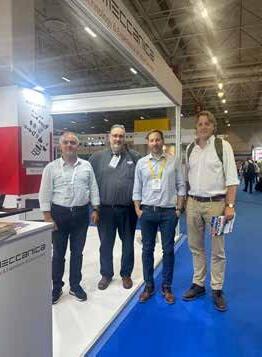
46 | August 2023 - International Aquafeed
Marco Prati, PLP Systems and Nick Mouthaan, Victam Corperation.
Industry Events
Future predictions of the leading associations of Türkiye:
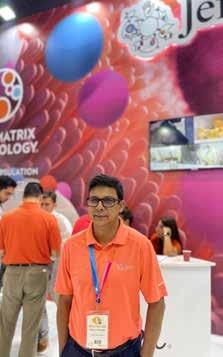

Turkish Feed Manufacturers Association / Mr. Ülkü Karakuş: In the last 10 years, compound feed production has increased by 7 percent every year, but it is striking that this growth rate was higher in previous years. Last year, 27 million tonnes of compound feed were produced in our country. Our country ranks 7th in the world and 1st among EU countries in terms of compound feed production. The development of our feed industry is directly related to our general economic policies and developments in the world, as well as agricultural policies. The pandemic and the Russia-Ukraine war have adversely affected social life and trade, leading to the deterioration of some balances. Stopping this war as soon as possible will relieve the world markets, increase the trade volume, make new investments and provide some new developments for
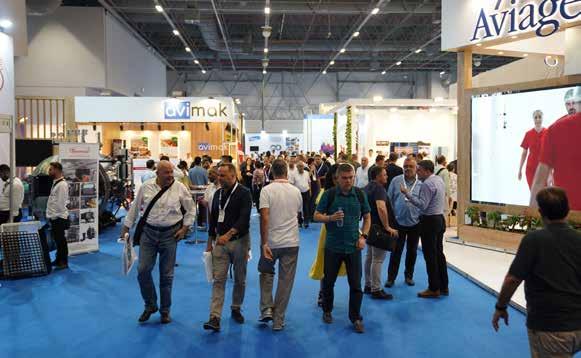
the benefit of our country. Thanks to the measures taken by our government through TMO, excessive increase in grain prices is prevented and feed prices are following a favourable course with the effect of intense competition in the market. Similarly, we anticipate that investments in animal production will increase, and the growth trend of the feed industry will continue in the coming period due to the regulation of the market, the elimination of the mentioned problems and the increasing need.
Veterinary Health Products Manufacturers Association (VİSAD) / Mr. Ramazan Bayhan: The demand for veterinary health products is expected to continue to increase due to various factors. These include a growing global population, increased pet ownership, increased awareness of animal health and welfare, and the expansion of the livestock industry to meet the demand for animal protein. The veterinary healthcare
47 | August 2023 - International Aquafeed
Kabir Chowdhury, Sales director, Jefo.
Industry Events
products industry has witnessed advances in technology such as the development of innovative pharmaceuticals, vaccines, diagnostics and digital health solutions, will continue. These technological advances can increase the efficacy, safety and convenience of veterinary treatments and improve overall animal health outcomes. Similar to the trend in human medicine, more and more emphasis is placed on preventive health care for animals. Veterinary healthcare products that promote preventive care, such as vaccines, parasite control products, and nutritional supplements, are expected to gain traction as pet owners and animal producers prioritize proactive measures to protect animal health and prevent disease. Regulatory control and standards for veterinary healthcare products are likely to become more stringent. Governments and regulatory agencies can enforce stricter rules to ensure the safety, quality and effectiveness of these products. Compliance with these regulations will be crucial for manufacturers and importers to maintain market access and consumer confidence. The concept of One Health, which recognizes the link between human, animal and environmental health, is becoming increasingly recognised and important. This awareness is likely to encourage the development of veterinary healthcare products that address zoonotic diseases (diseases that can be transmitted between animals and humans) and contribute to the overall health and well-being of both animals and humans.











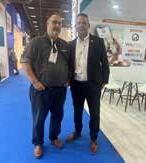


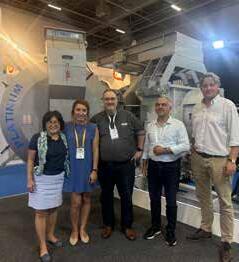
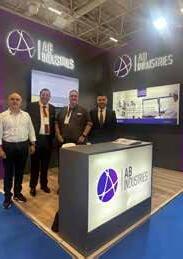
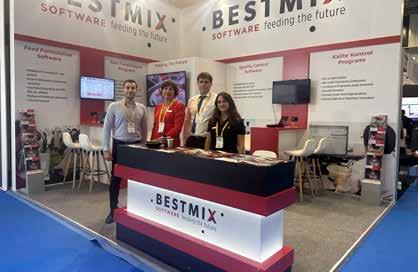
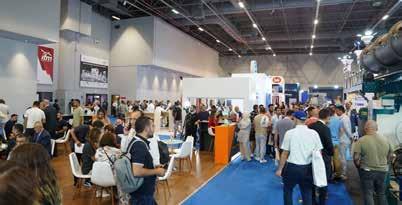
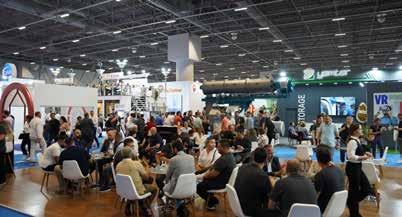 Begum Usta, Yemmak and Nick Mouthaan, Victam Corperation with Milling and Grain team.
Taner Alapala, Ekrem Acar of Alapala with Milling and Grain team.
Kemal Burak Kayhan, Bea Van Deynse, Arpad Zsok & Deniz Gungoroglu of Bestmix Software
Bulent T. Helvacikara, Bahadir Colak, Yemtar with International Aquafeed team.
Emre Ereren & Murat Cengiz of Imas with Milling and Grain team.
Christian Jordan of Jamesway Chick Master Incubator Inc with Darren Paris, Milling and Grain.
Begum Usta, Yemmak and Nick Mouthaan, Victam Corperation with Milling and Grain team.
Taner Alapala, Ekrem Acar of Alapala with Milling and Grain team.
Kemal Burak Kayhan, Bea Van Deynse, Arpad Zsok & Deniz Gungoroglu of Bestmix Software
Bulent T. Helvacikara, Bahadir Colak, Yemtar with International Aquafeed team.
Emre Ereren & Murat Cengiz of Imas with Milling and Grain team.
Christian Jordan of Jamesway Chick Master Incubator Inc with Darren Paris, Milling and Grain.
Industry Events 48 | August 2023 - International Aquafeed
Protect your profits
Mitigate risk through mycotoxin deactivation

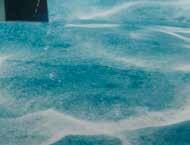

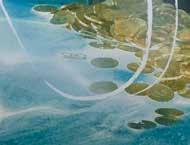


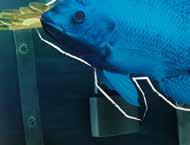


















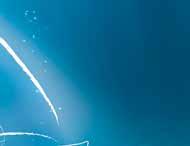

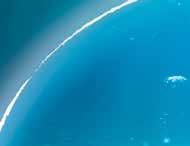

In addition to rising feed costs, mycotoxins further impact profitability by impairing growth performance and health status. The risk is never zero. Mycotoxin risk management is the insurance policy to secure feed quality and safety, whilst optimizing productivity.
Reduced risk
Increased productivity and efficiency
If not us, who? If not now, when? WE MAKE IT POSSIBLE
Sustainable production

www.dsm.com/anh
Follow









us on:
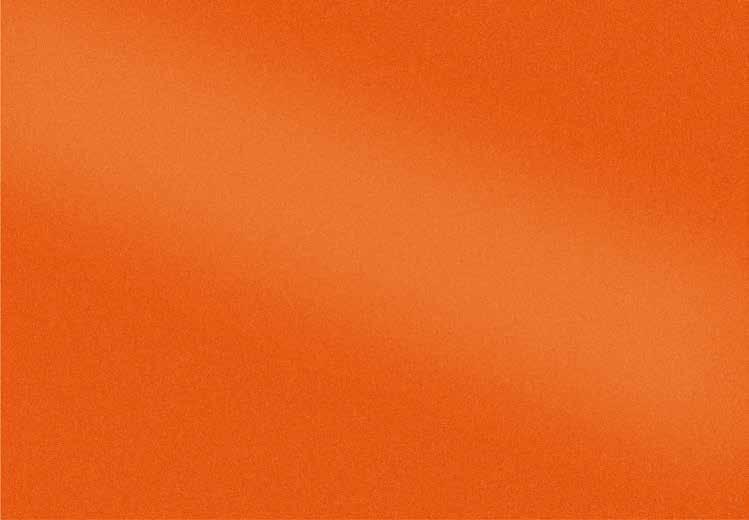














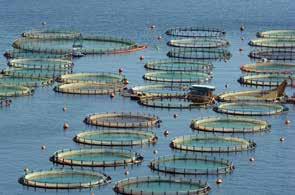
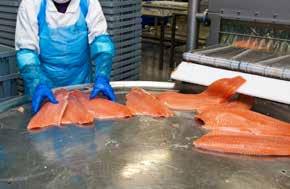
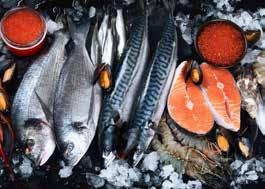
‘23 XIX NATIONAL SHRIMP FAIR NOVEMBER 14 - 17, 2023 - 2023 XIX INTERNATIONAL AQUACULTURE EQUIPMENT, PRODUCTS AND SERVICES TRADE SHOW XIX INTERNATIONAL SHRIMP FARMING SYMPOSIUM XVI INTERNATIONAL AQUACULTURE SYMPOSIUM XIX GASTRONOMIC SEAFOOD FESTIVAL WE HOPE TO SEE YOU IN THIS YEAR’S EDITION At the Natal Convention Center City of Natal - State of Rio Grande do Norte - Brazil. INFORMATION: WWW.FENACAM.COM.BR | FENACAM@FENACAM.COM.BR | +55 (84) 3231-6291 / +55 (84) 99612-7575 PROMOTION SUPPORT B E PA RT O F T H E M O ST I M P O RTA N T AQ UAC U LT U R E A N D S H R I M P FA R M I N G E V E N T I N L AT I N A M E R I C A ! 50 | August 2023 - International Aquafeed Industry Events



Seagriculture EU 2023
Shaping the future of the seaweed industry

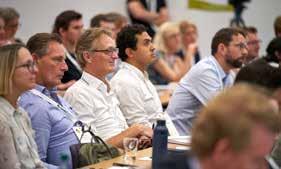
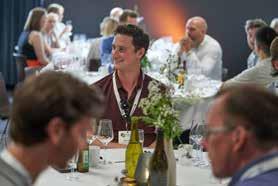 by Shannon Parsons, International Aquafeed, UK
by Shannon Parsons, International Aquafeed, UK
Seagriculture EU 2023, the leading conference for the seaweed industry, took place from 21 – 22 June 2023 with resounding success, bringing together an impressive gathering of industry professionals, researchers, policymakers, and entrepreneurs from around the world. The conference, hosted in Trondheim, Norway, showcased the immense potential of seaweed as a sustainable resource and explored innovative solutions to address climate challenges.
With a record attendance of 221 delegates from 26 countries, Seagriculture EU 2023 witnessed an unprecedented level of participation. More than 130 companies and institutions from various sectors actively engaged in discussions, networking, and knowledge sharing, highlighting the global interest in seaweed farming and its wide-ranging applications.
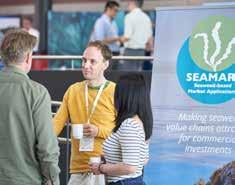
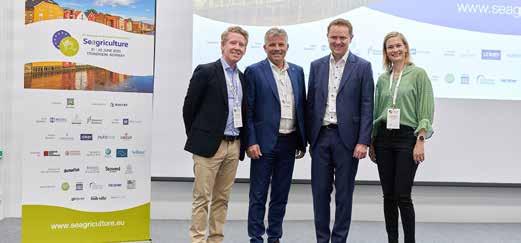
The conference featured an impressive line-up of keynote presentations with five renowned experts offering valuable insights into the latest developments and emerging trends in the industry. Additionally, a diverse panel of 30 speakers delivered seven informative sessions on topics ranging from cultivation techniques and product innovation to market trends and investment aspects. Some such notable speakers were Ole Christian Norvik, CEO of Seaweed Solutions, Urd Grandorf Bak, Chief Research Officer of Ocean Rainforest, Fredrik Åkerman, CEO and co-founder of Volta Greentech and many more.
There were also multiple opportunities for networking outside of the conferences, creating new contacts and reconnecting with old ones, re-establishing the relationships

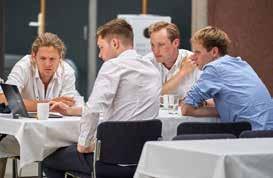

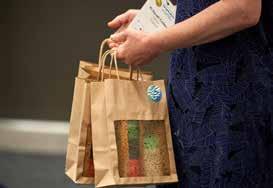
everyone has built throughout their time in the industry. With breaks for coffee and lunch provided by DLG, everyone was suitably happy. Along with these breaks, a Seaweed Happy Hour occurred on the first day for everyone to enjoy which was followed by a conference dinner.
In addition to the insightful presentations and wonderful chances to network, Seagriculture EU 2023 organised two captivating site visits for attendees to explore the world of seaweed. The visits included an immersive experience at Korsvika Beach, studying and tasting local seaweed species, and an enlightening tour to SINTEF and NTNU’s laboratories, showcasing cutting-edge research and a laboratory tour at campus Gløshaugen.
One of the highlights of Seagriculture
Industry Events
EU 2023 was the vibrant trade show, which saw the active participation of 14 exhibitors representing leading companies and organisations in the field of seaweed farming. The trade show provided a platform for showcasing cutting-edge technologies, sustainable practices, and ground-breaking products that contribute to the growth and advancement of the industry.
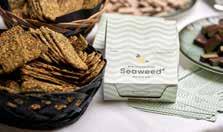
The event also featured an area with poster presentations, where 27 researchers had the opportunity to present their findings and engage in insightful discussions with fellow participants. This platform offered a unique opportunity to explore novel research and foster collaborations within the vibrant seaweed research community.
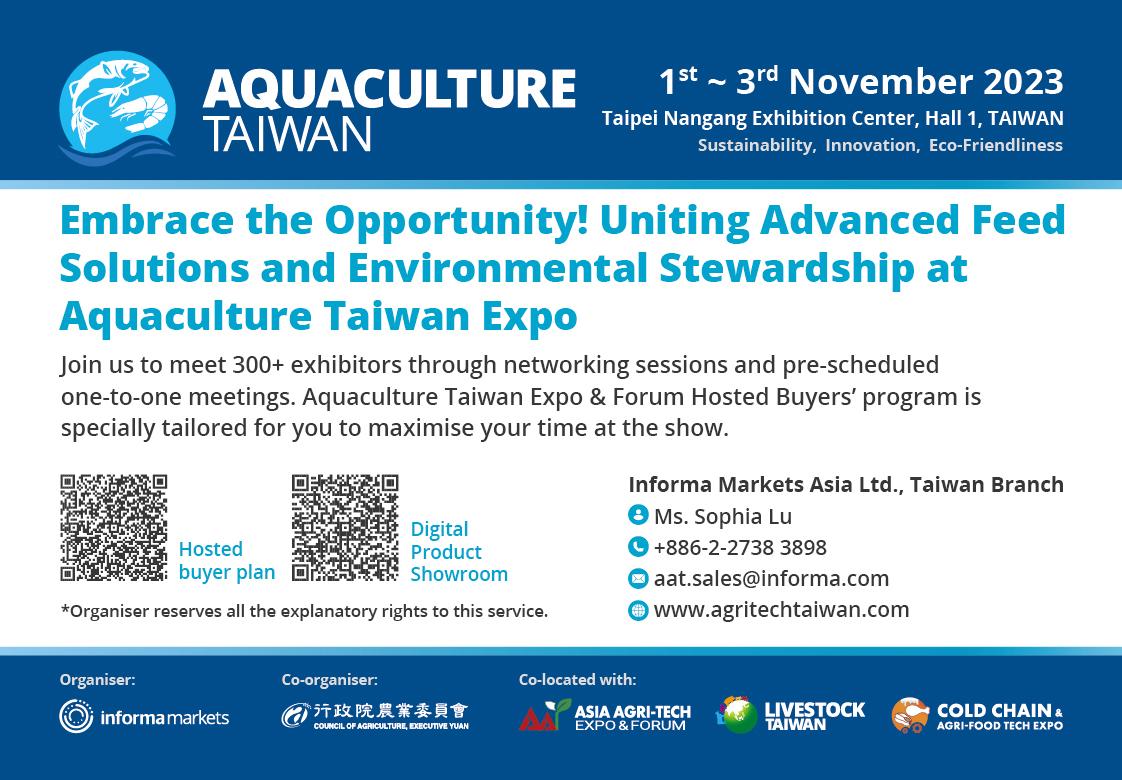
"We are thrilled with the overwhelming response and success of Seagriculture EU 2023," said Kuno Jacobs, Managing Director of the organiser DLG Benelux. "The enthusiastic participation of industry



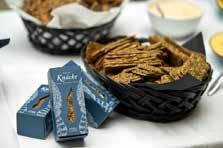
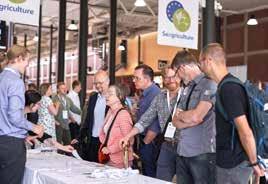
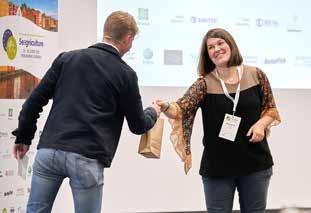 With a record attendance of 221 delegates from 26 countries, Seagriculture EU 2023 witnessed an unprecedented level of participation.
With a record attendance of 221 delegates from 26 countries, Seagriculture EU 2023 witnessed an unprecedented level of participation.
Industry Events
professionals, researchers, and policymakers underscores the growing recognition of seaweed as a vital component of a sustainable future. This conference has played a pivotal role in advancing knowledge, fostering partnerships, and propelling the seaweed industry towards a regenerative economy."

Seagriculture EU 2023 serves as a catalyst for innovation, collaboration, and knowledge exchange, paving the way for transformative advancements in the seaweed industry. By bringing together a diverse range of stakeholders, the conference has accelerated the adoption of sustainable practices, facilitated market growth, and positioned seaweed as a key solution to global climate challenges.
Seagriculture EU 2024 will take place from 18 – 20 June 2024 in Tórshavn, Faroe Islands. Next year’s conference promises to be a unique experience including an exclusive site visit to Oce an Rainforest on 18 June 2024. It is the first time the organisers offer such an extraordinary site visit within the Seagriculture conference.

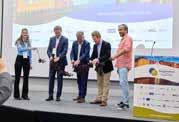

Moreover, the organizers want to invite you to the second edition of Seagriculture USA 2023 that will take place in Portland, ME on September 6 & 7. The conference offers the possibility to expand your knowledge and many networking opportunities to connect with other professionals in the industry.
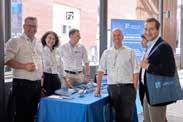

www.seagriculture-usa.com

Industry Events 54 | August 2023 - International Aquafeed

Aqua Nor 2023
The renowned Aquaculture exhibition and conference takes place on August 21-24 in Trondheim, Norway. The exhibition week kicks off with the Aqua Nor Conference, with the theme “More food from the oceans – Contributing to the green shift through expanding aquaculture production”. The conference is divided into three distinct parts, with many interesting topics.All lectures is held in English. The Aqua Nor Innovation Award Winner will be announced on the last day of the trade show.
Since 1979, Aqua Nor has been an important international meeting place for the aquaculture industry, and it is today the world’s largest aquaculture technology exhibition. In recent years, the Aqua Nor exhibition has drawn about 25,000 visitors from up to 76 nations to its halls. All the latest innovations of importance are presented to the industry.
The aquaculture industry has grown tremendously during the years since Aqua Nor first opened, and technology, processes and services related to farming salmon, other marine species, crustaceans, molluscs etc are represented at Aqua Nor. All the major aquaculture nations are present, either as exhibitors, visitors, or in official delegations.

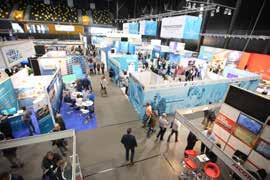
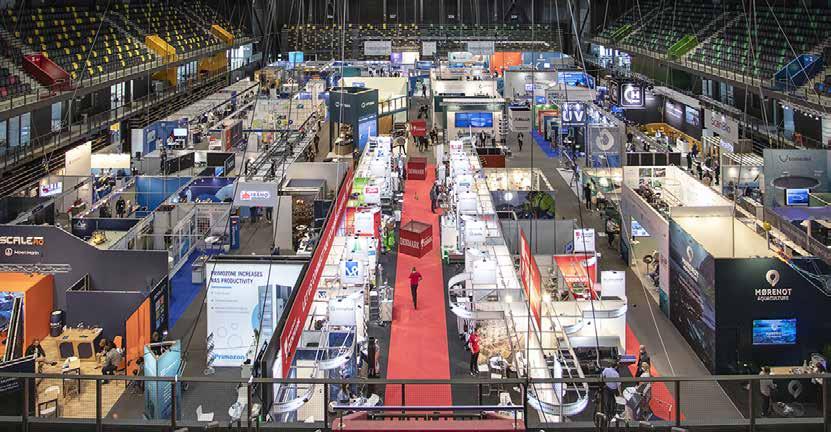
Modern aquaculture is today a knowledge industry with very advanced technology. This is true in all fields: in breeding, feed and feeding
regimes, biomass control, construction and operation of floating cages, nets, safety equipment, well boats, handling of fish, veterinary medicine, vaccines etc. The very latest innovations are presented at Aqua Nor. The Nor-Fishing Foundation is an ideal non-profit organisation, founded by the Norwegian Ministry of Fisheries in 1992. Through a variety of activities, the NorFishing Foundation contribute to and promote development in the maritime sector – regularly hosting international trade exhibition and exhibitions in Norway.
The two exhibitions are international meeting places for professionals in the industry. Today, Nor-Fishing and Aqua Nor are the world’s largest technology exhibitions in fisheries and aquaculture. The exhibitions are – and have always been – an important arena for development, innovation and marketing in the industry. In addition, they have become a forum for professional development, where conferences and seminars are organised with professional content concerning the latest technological developments in the industry.
56 | August 2023 - International Aquafeed




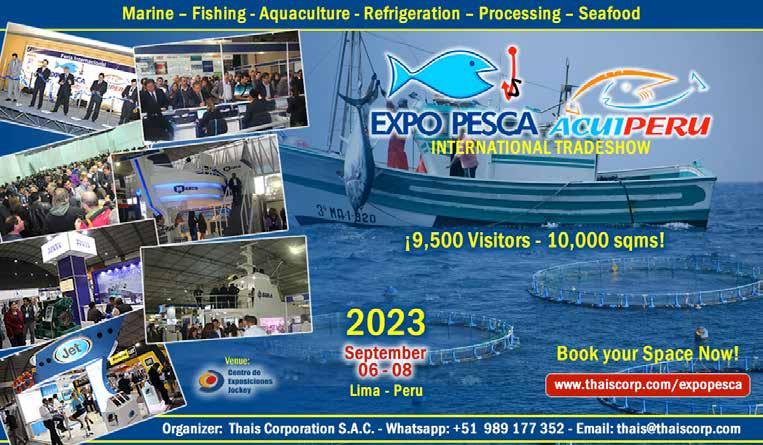
Your industry training platform The Online Milling School provides a comprehensive 12-week remote learning experience covering all aspects of feed milling, from raw material handling through to final packaging and dispatch. www.onlinemillingschool.com FISH FARMING TECHNOLOGY Live session: October 3, 2023 São Paulo Brazil International Aquafeed - August 2023 | 57
insights Counting down
October is approaching! The countdown has started for the first Victam LatAm event in São Paulo, Brazil that will take place from 3-5 October 2023! From process technology to ingredients and additives, it is all there.
The ingredients and additives market is a rapidly growing industry that is driven by the increasing demand for animal protein. The world population is growing, and with it, the demand for meat and dairy products. This demand drives the need for animal feed, which is a key component of livestock production. As the animal nutrition market evolves, there is a focus on improving animal health and performance, alternative ingredients, reducing the environmental impact of livestock production, and increasing efficiency and profitability for farmers.
Let's talk "ingredients"!
Feed additives, such as amino acids, enzymes and prebiotics are of importance in improving the nutritional quality of animal feed. In Latin America, the animal feed additives industry is particularly important due to the region's large and growing animal protein sector. According to a report by Grand View Research, the Latin America animal feed additives market size was valued at USD 6.5 billion in 2020 and is expected to grow at a compound annual growth rate (CAGR) of 3.1 percent from 2021 to 2028.
Following a report by the Brazilian Association of Animal Protein (ABPA), Brazil is the world's largest exporter of chicken meat and the fourth-largest exporter of pork, with exports of these products totaling 4.2 million tonnes and 1.1 million tonnes, respectively in 2020. The report notes that the Brazilian animal protein sector is a critical component of the country's economy, generating over 7 percent of the country's gross domestic product (GDP) and providing employment to over 4 million people. These data demonstrate the critical role that ingredients play in the animal nutrition industry and the need for continued innovation and development in this field.

Ingredient companies Victam LatAm 2023
The potential of the Brazilian and Latin American market attracted already over 150 companies as exhibitors at Victam LatAm 2023. Above the principal companies for feed ingredients

and feed machinery, Victam is also happy to welcome ingredient companies, such as Evonik, for instance.
Evonik is a leading player in the animal nutrition market and will be joining Victam LatAm 2023 with a stand in Latin America. The company is continuously developing new products and solutions that meet the evolving needs of farmers and the animal nutrition industry. With a focus on research and development, Evonik is well-positioned to help farmers produce high-quality animal products in a sustainable and efficient way. Evonik already has a significant presence in Latin America, with operations in Brazil, Mexico, Argentina, and Chile. The company's animal nutrition business in Latin America is focused on providing innovative and sustainable solutions that meet the needs of local farmers and the animal nutrition industry.
In Brazil, where the event will be held, Evonik operates a largescale production facility that produces MetAMINO, Biolys, and other animal nutrition products. Brazil is a key market for Evonik, as it is one of the world's largest producers of animal protein. The company has a strong local team in Brazil that is focused on providing technical support and expertise to customers.
In Mexico, Evonik has a sales and technical support team that works closely with local customers to provide innovative and sustainable animal nutrition solutions. The company's focus in Mexico is on improving animal health and performance, reducing the environmental impact of livestock production, and increasing efficiency and profitability for farmers.
In Argentina, Evonik has a strong presence in the animal nutrition market, with a focus on providing amino acid solutions for poultry and swine diets. The company's products are used by many of the leading animal nutrition companies in the region.
In Chile, Evonik is focused on providing innovative and sustainable solutions for the aquaculture industry. The company's products are used in salmon and trout diets, and are designed to improve animal health and performance, reduce feed costs, and increase profitability for farmers.
Overall, Evonik's animal nutrition business in Latin America is focused on providing high-quality, sustainable solutions that meet the evolving needs of local farmers and the animal nutrition industry. Victam LatAm 2023 will be the ideal opportunity for Evonik to maintain current relations in the region and develop new ones.
VICTAM insights - August 2023 | 58
Interview Evonik



Victam reached out to Henrique Brand - Strategic Marketing Manager for Specialties Nutrition at Evonik, to inform us on Evonik “Insights”!
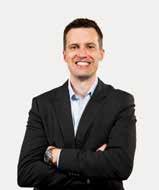
In recent years what are the most critical technological developments that you have witnessed in the nutrition sector?
In recent years, the animal nutrition sector has been seeking viable alternatives to the use of antimicrobials in feed. These alternatives range from the use of additives such as probiotics, postbiotics and organic acids, to the application of nutritional concepts such as the reduction of crude protein in diets and supplementation with functional amino acids.
What are your sustainability focus areas?
Reducing the carbon footprint of our production plants and helping our customers reduce environmental contamination with the use of amino acids, nutritional and animal health additives.
You present yourself as a leader in innovation. Can you tell us a little bit more about your innovation(s)?
Through partnerships with research centers and universities around the world, we have been able to develop new products and technologies that will be applied in animal production in the coming years.
For example, we have a research line to define the amino acid requirements for animals raised under heat stress. In this way, we can help our customers optimise their production and reduce their losses due to climatic factors.
We are pleased to have you on board for Victam LatAm, what potential do you see in Latin America?
Latin America is a region with many opportunities for agribusiness and this has made the world's largest companies interested in investing in the region. With an abundance of land and water, the region offers all the necessary factors for the efficient and sustainable production of animal protein. Therefore, Evonik is present in the region to be part of the production chain offering high performance solutions to meet the demands of producers.
Conferences in São Paulo, Brazil
Perendale Publishers has partnered with VICTAM to host three conferences during the LatAm event in São Paulo, Brazil. On October 3-4, there will be two half-day conferences held, to hear from industry experts about Aquaculture feed and Petfood production. The ‘Pet-Aqua feed production conference’ covers these two areas that utilise similar techniques, and is designed for understanding the process, learning what is new, and possibilities in the area of pet and aquatic feed production.

As an additional session for our Online Milling School, the ‘OMS-Offline: Trouble shooting for all (Milling-Aqua-Pet)’ will take place on October 3 and will comprise of a discussion panel and a Q&A session. During this Off-Line Session, we will be awarding Certificates of Attendance to those who have completed one of the 2023 six-week courses and who are in attendance.

The ‘Feed Milling Maximised’ conference takes place on October 5. The seminar presents keynote presentations along with eight quick-fire updates on equipment and technologies used in modern-day feed milling that improve efficiencies while maximising output.
To register, visit https://victamlatam.com/en-us/conference-program/conferences

VICTAM insights - August 2023 | 59
aquafeed.co.uk/web/companies

Welcome to the market place, where you will find suppliers of products and services to the industry - with help from our friends at The International Aquafeed Directory (published by Turret Group).
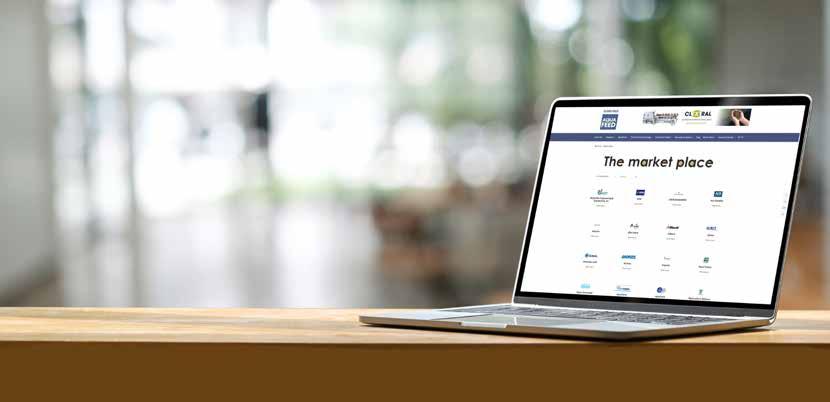

Aerators
Faivre + 33 3idah 81 84 01 32

www.faivre.fr
PROFILE: aqfeed.info/e/1603
Air products
Kaeser Kompressoren
+49 9561 6400
www.kaeser.com

PROFILE: aqfeed.info/e/1035
Additives
DSM
+43 2782 8030
www.dsm.com
PROFILE: aqfeed.info/e/1605
Jefo
+1 450 799 2000
https://jefo.ca

PROFILE: aqfeed.info/e/1607
Liptosa
+34 902 157711
www.liptosa.com

PROFILE: aqfeed.info/e/1608
SAS Laboratories Phode

+33 5 63 77 80 60
www.phode.com
PROFILE: aqfeed.info/e/1644
Analysis
Romer Labs

+43 2272 6153310
www.romerlabs.com
PROFILE: aqfeed.info/e/1610
Bulk storage
TSC Silos +31 543 473979
www.tsc-silos.com

PROFILE: aqfeed.info/e/1612
Conveyors
Computer software
Inteqnion +31 543 49 44 66
www.inteqnion.com


PROFILE: aqfeed.info/e/1277
Coolers & driers
Bühler AG +41 71 955 11 11
www.buhlergroup.com
PROFILE: aqfeed.info/e/1614
FAMSUN
+86 514 85828888
www.famsungroup.com

PROFILE: aqfeed.info/e/1034
IDAH
+866 39 902701
www.idah.com

PROFILE: aqfeed.info/e/1615
Wenger Manufacturing

+1 785-284-2133
www.wenger.com
PROFILE: aqfeed.info/e/1616
Drum filters
Faivre + 33 3 81 84 01 32 www.faivre.fr
PROFILE: aqfeed.info/e/1603
Faivre is a French company, and one of the world leaders in the conception, manufacture and production of aquaculture machines.
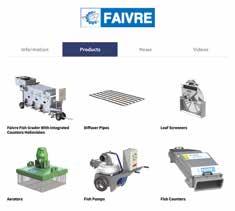


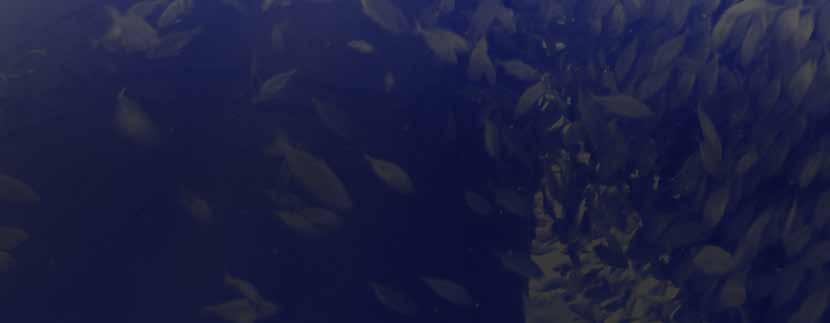
Since 1958, thanks to their knowledge of the market and strong experience in aquaculture, Faivre has developed high quality products to satisfy all of your needs, from one product to the full installation. Strength, effectiveness and simplicity are the qualities of their production.
aqfeed.info/e/1603
Elevator buckets
Cablevey Conveyors +1 641 673
https://cablevey.com
Enginnering +32 67 89 50 41 www.vigan.com aqfeed.info/e/1648
8451
PROFILE: aqfeed.info/e/1613 Vigan
Tapco Inc +1 314 739 9191 www.tapcoinc.com aqfeed.info/e/1654 60 | August 2023 - International Aquafeed
Elevator & conveyor components
4B Braime +44 113 246 1800
www.go4b.com
aqfeed.info/e/1655

Enzymes
DSM +43 2782 8030
www.dsm.com
PROFILE: aqfeed.info/e/1605
Equipment for sale
ExtruTech Inc









+1 785 284 2153
www.extru-techinc.com

PROFILE: aqfeed.info/e/1618
Extruders
Almex

+31 575 572666
www.almex.nl
PROFILE: aqfeed.info/e/1279
Buhler AG
+41 71 955 11 11
www.buhlergroup.com
PROFILE: aqfeed.info/e/1614
IDAH +866 39 902701
www.idah.com
PROFILE: aqfeed.info/e/1615
Ottevanger +31 79 593 22 21
www.ottevanger.com
PROFILE: aqfeed.info/e/1621
Wenger Manufacturing

+1 785-284-2133
www.wenger.com
PROFILE: aqfeed.info/e/1616
Zheng Chang
+86 2164184200
www.zhengchang.com
PROFILE: aqfeed.info/e/1623
Feed and ingredients
Adisseo
+33 1 46 747104
www.adisseo.com

PROFILE: aqfeed.info/e/1624
Aller Aqua
+45 70 22 19 10
www.aller-aqua.com

PROFILE: aqfeed.info/e/961
Alltech
+44 1780 764512
www.alltechcoppens.com
PROFILE: aqfeed.info/e/1625
Anpario
+44 1909 537 380
www.anpario.com

PROFILE: aqfeed.info/e/1626
Biorigin
www.biorigin.net
PROFILE: aqfeed.info/e/1627
GePro
+49 54415 925252
www.ge-pro.de aqfeed.info/e/1656
Grand Fish Feed
+202 20 650018
www.grand-aqua.com
PROFILE: aqfeed.info/e/1628
Jefo
+1 450 799 2000
https://jefo.ca

PROFILE: aqfeed.info/e/1607
Liptosa
+34 902 15 77 11
www.liptoaqua.com
PROFILE: aqfeed.info/e/1608
Phileo (Lesaffre animal care)

+33 3 20 81 61 00
www.lesaffre.fr
PROFILE: aqfeed.info/e/1629
Feed Mill
TekPro
+44 1692 403403
www.tekpro.com

PROFILE: aqfeed.info/e/1631
Tietjen Verfahrenstechnik GmbH
+49 4106 6333 0
www.tietjen-original.com
PROFILE:
Van Aarsen International
+31 475 579 444
www.aarsen.com
PROFILE: aqfeed.info/e/1632
Fish counters
Faivre
+ 33 3 81 84 01 32
www.faivre.fr
PROFILE: aqfeed.info/e/1603
Fish Graders
Faivre + 33 3 81 84 01 32
www.faivre.fr



PROFILE: aqfeed.info/e/1603
Fish pumps
Faivre + 33 3 81 84 01 32 www.faivre.fr PROFILE: aqfeed.info/e/1603
Grinders
Grand Fish Feed +202 20 650018



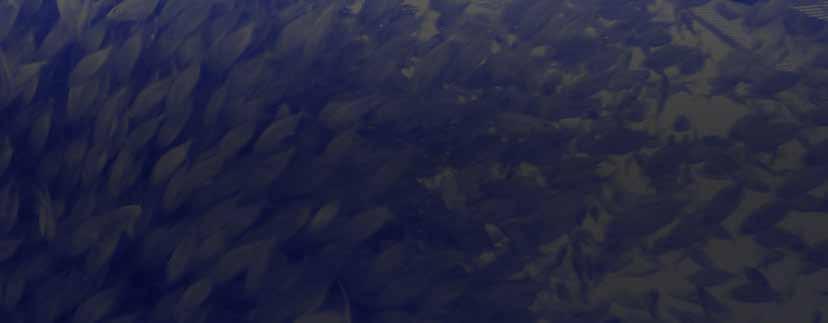
www.grand-aqua.com
PROFILE: aqfeed.info/e/1628
Hammermills
Dinnissen BV +31 77 467 3555
www.dinnissen.nl
PROFILE: aqfeed.info/e/1633
Tietjen Verfahrenstechnik GmbH
+49 4106 6333 0
www.tietjen-original.com
PROFILE:
Moisture analysers
Hydronix +44 1483 468900
www.hydronix.com

PROFILE: aqfeed.info/e/1634
Packaging
FAWEMA / The Packaging Group

+49 22 63 716 0
www.fawema.com
PROFILE: aqfeed.info/e/1635
Paddle Mixer
Anderson www.andersonfeedtech.com aqfeed.info/e/1658
IDAH
+866 39 902701
www.idah.com
PROFILE: aqfeed.info/e/1615
Palatability enhancers
Symrise

https://aquafeed.symrise.com

PROFILE: aqfeed.info/e/1739
Pellet mill
IDAH
+866 39 902701
www.idah.com
PROFILE: aqfeed.info/e/1615
PTN
+31 73 54 984 72
www.ptn.nl
PROFILE: aqfeed.info/e/1636
Plants
Buhler AG
+41 71 955 11 11
www.buhlergroup.com
PROFILE: aqfeed.info/e/1614
Dinnissen BV +31 77 467 3555
www.dinnissen.nl
PROFILE: aqfeed.info/e/1633
FAMSUN
+86 514 87848880
www.muyang.com
PROFILE: aqfeed.info/e/1034
Ottevanger +31 79 593 22 21
www.ottevanger.com
PROFILE: aqfeed.info/e/1621
Zheng Chang +86 2164184200
www.zhengchang.com

PROFILE: aqfeed.info/e/1623
Pulverisers
IDAH
+866 39 902701
www.idah.com




PROFILE: aqfeed.info/e/1615
To include your company in the International Aquafeed market place in print, and a company page on our website contact Tuti Tan +44 1242 267700 • tutit@perendale.co.uk
To visit the online market place visit: www.aqfeed.info/e/1130

61 | August 2023 - International Aquafeed
•
•
•
•
•




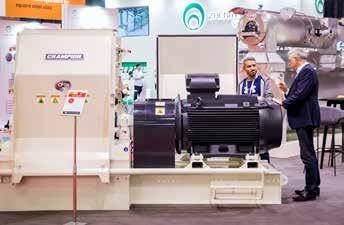

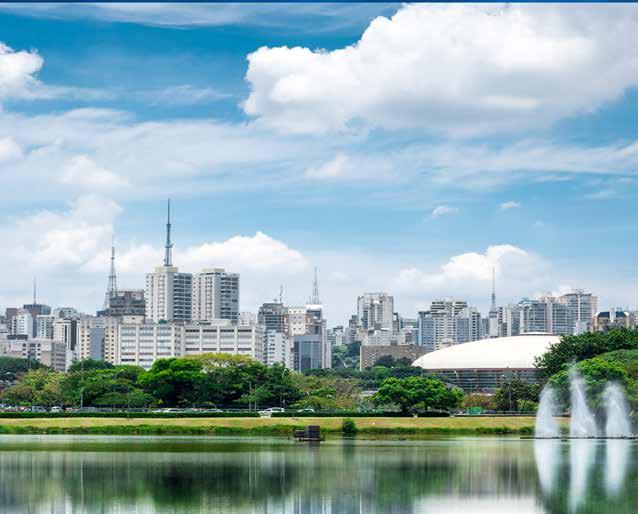
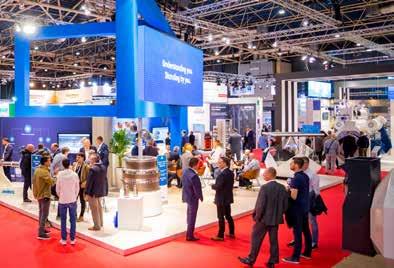
OCTOBER 2023 NEW! SÃO PAULO BRAZIL
AMERICA’S
DEDICATED EVENT FOR THE ANIMAL FEED AND GRAIN PROCESSING INDUSTRIES
3-5
LATIN
LARGEST
Animal Feed
Agua Feed
Pet food
Poultry feed
•
Flour milling
Grain processing, handling & storage MORE INFORMATION � NICKMOUTHAAN@VICTAM.COM � +31 6 2126 4398 � WWW.VICTAMLATAM.COM
INFORMATION
the QR code or visit victamlatam.com FOUNDING COMPANIES
MORE
Scan
Probiotics
DSM +43 2782 8030
www.dsm.com
PROFILE: aqfeed.info/e/1605
Royal DSM is a global, purpose-led company in Health, Nutrition & Bioscience, applying science to improve the health of people, animals and the planet. DSM’s purpose is to create brighter lives for all. DSM’s products and solutions address some of the world’s biggest challenges while simultaneously creating economic, environmental and societal value for all its stakeholders - customers, employees, shareholders, and society at large. DSM and its associated companies employ approximately 23,000 people around the world and deliver annual net sales of about €10 billion.
DSM use their bright science to deliver positive transformations at scale for as many people as possible today and for generations to come, operating within the constraints of the world’s finite resources. DSM aim to redefine how they live and work in order to create a fairer, more prosperous and more sustainable society.
In Animal Nutrition and Health
The DSM Animal Nutrition and Health business group offers customers a true end-to-end portfolio of products, solutions and services for sustainable and profitable animal farming. The company’s three dedicated business lines cover Precision Services, Performance Solutions + Biomin® and Essential Products.

Precision Services
Greater precision in animal farming is key to a more sustainable and profitable future. Their Precision Services use the latest data analytics and diagnostics to improve animal health, lifetime performance, resource use and environmental footprint — while mitigating risks and unlocking more value. Improving the sustainability and profitability of animal farming is secured with, aqfeed.info/e/1605
Phytogenics
Delacon
RAS Equipment
Fish Farm Feeder
PROFILE: aqfeed.info/e/1638
FishFarmFeeder is a company founded in 2008 that manufactures feeding systems for aquaculture with a complete catalog of feeders that cover all stages of the fish's life: hatchery, pre-grower and grow-out, both on land and at sea.
FishFarmFeeder’s mission is to:
• Offer globally specialized solutions only in the field of feed automation for aquaculture. Contribute to a sustainable aquaculture helping to optimize production and improving fish welfare.
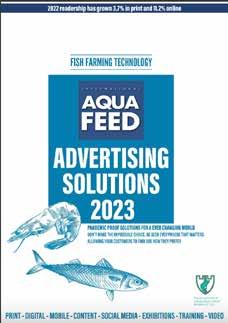

• Respond to the needs of automation in the feeding of all stages of the fish's life.
• Develope a profitable, reliable, accurate and safe technology.

Facilitate integration with other existing technologies in aquaculture such as sensors, software aqfeed.info/e/1603

Silos
RAS system
Aqua Ultraviolet +1 952 296 3480
www.aquauv.com

PROFILE: aqfeed.info/e/1639
FAMSUN
+86 514 85828888
www.famsungroup.com
PROFILE: aqfeed.info/e/1034
TSC Silos
+31 543 473979
www.tsc-silos.com

PROFILE: aqfeed.info/e/1612
Vacuum
Dinnissen BV +31 77 467 3555
www.dinnissen.nl
PROFILE: aqfeed.info/e/1633
Weighing equipment
Ottevanger +31 79 593 22 21
www.ottevanger.com
PROFILE: aqfeed.info/e/1621
Yeast products
Leiber GmbH +49 5461 93030

www.leibergmbh.de
PROFILE: aqfeed.info/e/1640
Phileo (Lesaffre animal care) +33 3 20 81 61 00

www.lesaffre.fr
PROFILE: aqfeed.info/e/1629
For more information about our market place - please view or download our 2023 media kit
https://aqfeed.info/e/1529

+43
732 640 531 414 www.delacon.com PROFILE: aqfeed.info/e/1637
+34 886 317 600 www.fishfarmfeeder.com
63 | August 2023 - International Aquafeed
the interview
Dr
Philippe Tacon
Director Business Development - Animal Health, Adare Biome (a subsidary of dsm-firmenich), France
Dr Tacon has over 25 years of experience in the field of animal nutrition, both as a scientist and business leader. He has spent more than 10 years with Phileo Lesaffre Animal Care in Asia and Europe where he successfully developed the commercial portfolios for both aquaculture and livestock activities. He is currently positioned as the Director Business Development - Animal Health at Adare Biome, France.
You have a rich 25+ year career in the industry, what initially lead you to get into this field?
Well, I came to it mostly following a streak of opportunities rather than a dedicated career choice. I was primarily involved in academia working on the reproductive aspects of fish both in France and Asia. Then I worked in the medical field by the lack of opened position in aquatic research. It was by the chance of a family move to Thailand that I came to be involved in applied research in feed additives for shrimp farming, then I stayed on, moving to more commercial positions mostly working from different Asian countries.
What in your opinion is the worst impact the pandemic had on the feed industry?
The industry faced many challenges during the pandemic with a strong control in the movement of workers and a decrease of demand. In retrospect, we can see that the feed industry was rather resilient at a local level towards these challenges. Most of the feed companies managed to keep their activities going despite the restrictions. The industry kept well informed through online meetings and webinars. Governments in Europe have put forward protocols to maintain “business as usual”.
Nevertheless, the industry has been deeply, and still is, impacted by restrictions on supply. Port closures and the difficulty to find ships led to a decrease in grain and raw material trading. Linked to the increased of shipping costs, this limited supply, increased the feed formula cost. This impact has further amplified with the recent events in eastern Europe.
What are the most critical technological development taking place in feed sector in recent years from your perspective?
That must be precision feeding to allow animal to fulfil their growth potential. I see also the new developments to analyse microbiome in individual animals, or in pens or flocks as one the most interesting advances recently. Gut health and microbiome were of course a major focus in animal nutrition in the last 10 or 15 years. But now, more and more feed and feed additives companies are providing services or kits to instantly give a picture of the bacterial populations in the gut. This permits the early detection of potential dysbiosis, pathogen presence, subclinical
issues and induce the remediation by changing feed composition and supply dedicated additives for example. Being an endocrinologist by training involved in probiotics and postbiotics in most of my career, I see gut health and the gut brain axis as one of the promising technological developments to come, together with precision feeding.
What do you see as the key challenges facing a growing feed sector in your view?
Sustainability will be the key challenge. First sustainability for the feed sector, indeed the whole value chain will have to work to ensure that costs are controlled to maintain food security and food safety and provide affordable access to animal proteins. We are already seeing a shift of the consumers for cheaper products (the decrease of demand for organic product in France is a good example). The sourcing of environmentally sustainable raw materials will also be a major concern.
With the pandemic, the recent events in Eastern Europe and the effect of climate change to come, cost and availability of raw materials will remain a strong challenge for the industry for the years to come. That will force the industry either to work to incorporate cheaper, and probably locally sourced, material and to improve the feed to gain ratio either by a change of feeding practices or the use of dedicated additives. Improving management practices for feed benefit will also go in parallel with a better animal welfare and reduction of stress.
How challenging was the shift in your career from Aquafeed sector to animal health?
It was quite easy to be honest. I have an animal production master’s degree, I come from a major swine production area in France, and I did my PhD thesis at the INRAE institute in France, so I was very aware of other species production. I must say that the livestock sector is easier to approach then the aquaculture one, as it is much more structured. Apart from the salmon industry, the aquaculture sector is still very fragmented, with multiple species, multiple culture practices and environments. Strangely also I found the livestock industry more willing to share information with suppliers. There is still a black box, secretive feeling when dealing with fish and shrimp companies. But I miss going to aquaculture events, it is a very close-knit sector.
64 | August 2023 - International Aquafeed
Going forward, what aspects of nutrition and production would you like to see addressed and why?
Large production systems will remain in place in the near future, and I think it is important that the industry moves towards the incorporation of more locally sourced material and a more circular way of producing animal proteins. This move will provide benefits on both economic and environment standpoints and will most probably be easier to do in some production models than other. To that regard, I think aquaculture could lead the way, it has already implemented this trend for many years by the reduction of fish meal in feed formula and can push further the reuse of material and the use of alternative protein sources when costs will be reduced. Along with poultry, aquaculture is a very efficient way to produce proteins and I hope it will gain more momentum in the years to come, and I would like to see this happen in regions like Africa.
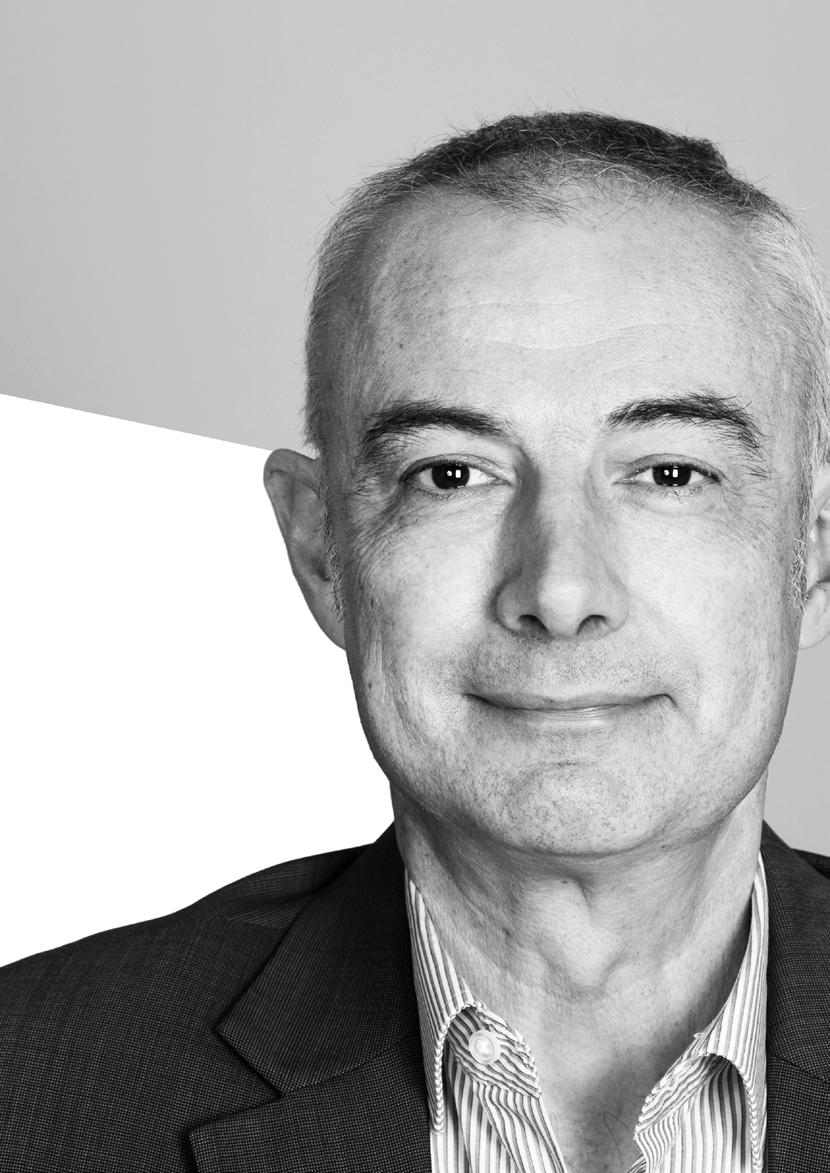
International Aquafeed - August 2023 | 65
THE INDUSTRY FACES
Adisseo announces the appointment of Dr HAO Zhigang as CEO

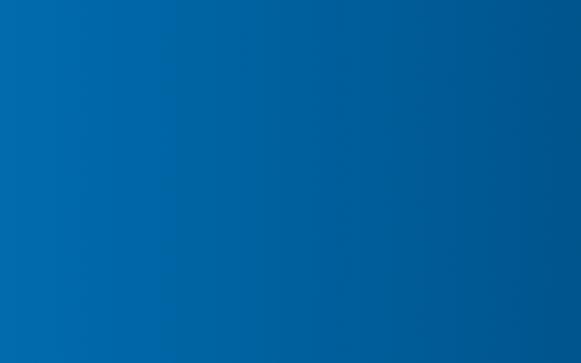

Dr HAO Zhigang, Chairman of Adisseo's Board of Directors for more than 5 years, starts to undertake the role of Chief Executive Officer since 1st July following the leaving of Jean-Marc DUBLANC from his operational duties in Adisseo.
This succession, well anticipated and prepared, ensures a smooth transition to maintain and strengthen Adisseo's strategy and organisation.
Dr. HAO Zhigang has been with Sinochem/Bluestar for around two decades in a variety of executive, operational and managerial positions. Having involved in Adisseo business since 2010, he has intensive cross-cultural communication and management experience.
Dr HAO Zhigang, as Chief Executive Officer of Adisseo, and in addition to his current Chairman role both at Adisseo and at Bluestar, manages the coordination and relations with Adisseo’s shareholders, enabling a decision-making process with faster speed and higher efficiency, which is critical under current macro-environment with great uncertainties and volatilities.
He is also responsible for Adisseo Group strategy and directly supervises Adisseo executive members including Frédéric Jacquin, Chief Operating Officer, as well as other five executive vice presidents responsible for finance, strategy and sustainability, Research & Innovation, HR and China operations respectively.

Ÿnsect announces their new CEO - Shankar Krishnamoorthy

On 6 July, the Ÿnsect board of directors announced their growth plans and with that, shared the new appointment of the new Chief Executive Officer, Shankar Krishnamoorthy.
Shankar Krishnamoorthy is a former member of Engie’s executive committee, joining Ÿnsect in 2021 and leading the company’s international expansion to Amiens, France.
“I am honoured by the trust the board has placed in me and am thrilled to lead Ÿnsect into its next stage of growth,” Krishnamoorthy said. “I wish to thank Antoine for his dedication and commend his vision in launching Ÿnsect and in leading the company through its formative years. I look forward to working with all Ÿnsectors to tackle our challenges collectively and to relentlessly work to accomplish our mission.”
Stepping down as CEO is Antoine Hubert, Co-Founder of Ÿnsect, who is moving into the role of executive vice president and CŸO.
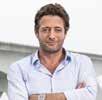
“In 12 years, together with our shareholders and our teams, we have risen to immense challenges to make Ÿnsect a leading company in the production of insect proteins for food, pets and plants,” Hubert said. “Today, and while our flagship site in Amiens is achieving a major milestone in its start-up phase, Ÿnsect has reached a point that requires us to adapt our organization. Therefore, I am handing over the operational reins of the company to Shankar, a seasoned professional that I fully trust and who has demonstrated his great qualities within Ÿnsect over the past two years, thus ensuring the best possible continuity for our teams and our stakeholders.”
RAS announces new Chairman of the Board – Ohad Maiman
BioFishency, a provider of electro-chemical and biological water treatment solutions for Recirculated Aquaculture Systems (RAS) announced that it has named internationally acclaimed RAS expert, and venture capital frontrunner, Ohad Maiman as its new Chairman of the Board. Maiman, Founder and former CEO of the prominent, publicly-traded The Kingfish Company (KING.OL), and Founder and Managing Partner of AquaFounders Capital, brings a broad set of technological and business management expertise in the land-based aquaculture sector. In his new role, Maiman will leverage his unique experience, enabling BioFishency to reinforce its position as one of the world's leading disruptive RAS water treatment solutions providers.
Maiman is currently the Founder and Managing Partner of AquaFounders Capital, an investment company focused on securing a strategic position in the land-based aquaculture sector across the value chain. Prior, Maiman was Founder and CEO (2015-2022) at The Kingfish Company, where he led the company to becoming one of the world's flagship RAS producers with the development of landbased RAS Yellowtail Kingfish in the Netherlands, and the USA.
66 | August 2023 - International Aquafeed
Since 1958, Faivre has developed and manufactured high quality equipment for the aquaculture industry.



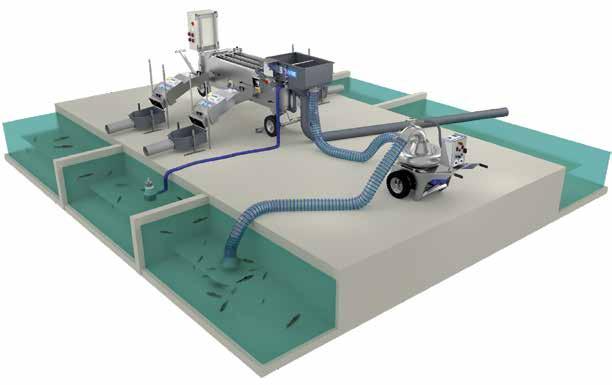



A complete range of filters, built to handle from 3 l/s to 1200 l/s

=
NEW Spiderplate ® www.faivregroup.com

Available now
15 different packs, made to manage fish from 1g. to 3,5kg.
FAIVRE G roup l 7 rue de l’industrie l 25110 Baume-Les-Dames l France TRUSTED EXPERIENCE SINCE 1958 DRUM
FILTERS
GRADING PACK
+ +





























































 Yan, the Supervisor, R&D Global Application Center & David Ma, Deputy Director, R&D Institute, Famsun, China
Yan, the Supervisor, R&D Global Application Center & David Ma, Deputy Director, R&D Institute, Famsun, China





























































































































 By Mehmet Uğur Gürkaynak, International Aquafeed, Türkiye office
By Mehmet Uğur Gürkaynak, International Aquafeed, Türkiye office























 Begum Usta, Yemmak and Nick Mouthaan, Victam Corperation with Milling and Grain team.
Taner Alapala, Ekrem Acar of Alapala with Milling and Grain team.
Kemal Burak Kayhan, Bea Van Deynse, Arpad Zsok & Deniz Gungoroglu of Bestmix Software
Bulent T. Helvacikara, Bahadir Colak, Yemtar with International Aquafeed team.
Emre Ereren & Murat Cengiz of Imas with Milling and Grain team.
Christian Jordan of Jamesway Chick Master Incubator Inc with Darren Paris, Milling and Grain.
Begum Usta, Yemmak and Nick Mouthaan, Victam Corperation with Milling and Grain team.
Taner Alapala, Ekrem Acar of Alapala with Milling and Grain team.
Kemal Burak Kayhan, Bea Van Deynse, Arpad Zsok & Deniz Gungoroglu of Bestmix Software
Bulent T. Helvacikara, Bahadir Colak, Yemtar with International Aquafeed team.
Emre Ereren & Murat Cengiz of Imas with Milling and Grain team.
Christian Jordan of Jamesway Chick Master Incubator Inc with Darren Paris, Milling and Grain.












































 by Shannon Parsons, International Aquafeed, UK
by Shannon Parsons, International Aquafeed, UK













 With a record attendance of 221 delegates from 26 countries, Seagriculture EU 2023 witnessed an unprecedented level of participation.
With a record attendance of 221 delegates from 26 countries, Seagriculture EU 2023 witnessed an unprecedented level of participation.

















































